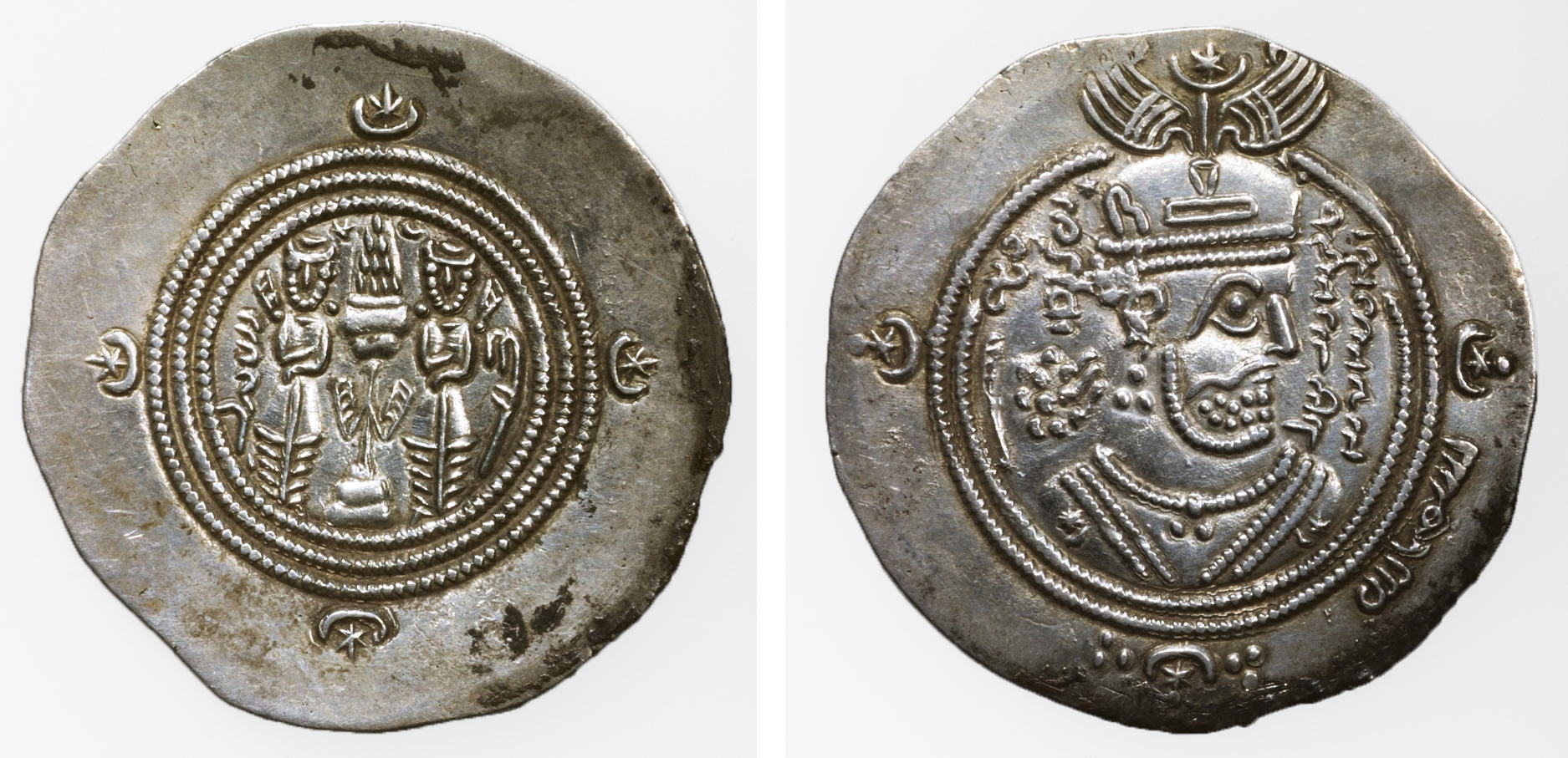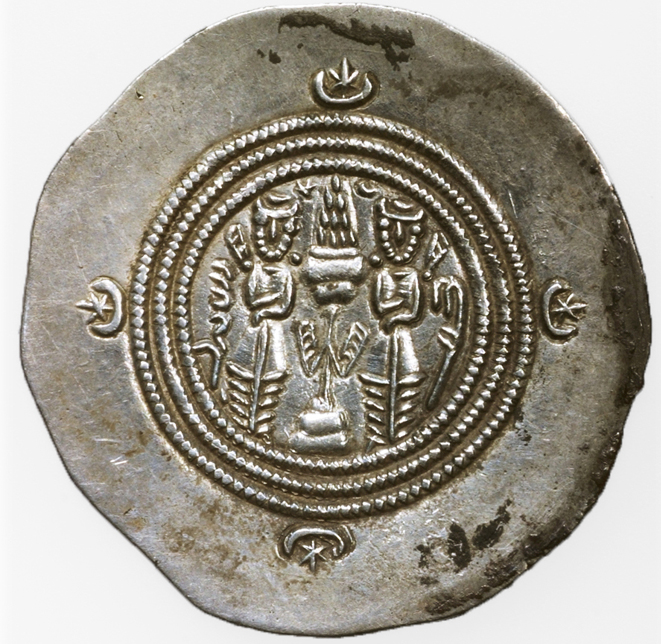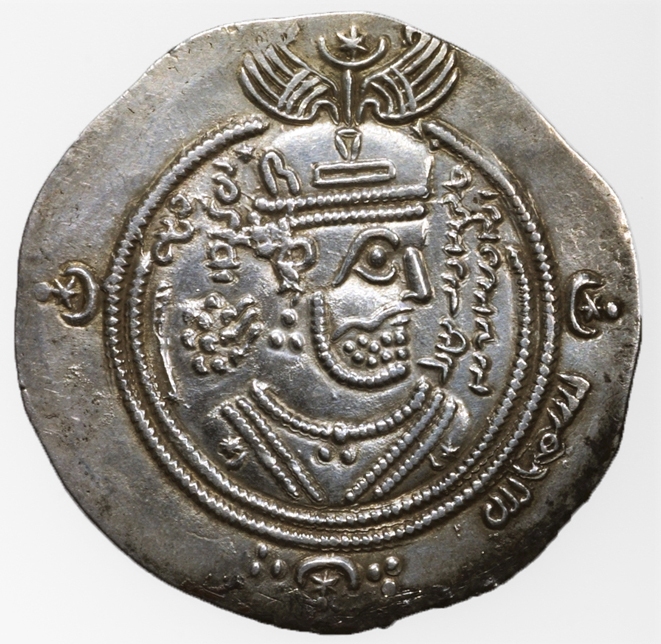 Print Page
Print Page
 Print Page
Print Page
Location: Japan
Materials: Wood, lacquered in togidashi-e, takamaki-e, hiramaki-e and nashiji, with inlay of ivory, bone, and shell; silvered and gilded fittings
Dimensions: 227 x 159 x 58.0 cm
Accession Number: LX43
Other Notes:
Produced by the Samurai Shokai Company.
This sumptuously decorated cabinet was purchased early in 1909 from Samurai Shokai by Baron R. von Swaine of Schloss Theres, Hasfurt, Unterfranken, Germany. The price was 1,000 yen, equivalent at that time to 2,050 marks. A letter of April 23, 1909, from Samurai Shokai (“Wholesale and retail of high art curios”) assures the Baron that:
“The cabinet is one of the most beautiful ones to be found in Japan and we feel sure that you will be perfectly satisfied with it and it will become centre of the admiration of those who know something about the arts. It is gold lacquer and worked with the beautifully cut inlaid mother of pearl design representing different remarkable events in our history.”
In 1910 the Samurai Shokai, supplied a cabinet (also in the Khalili Collections, LX37) which may have been intended for the Japan-British Exhibition.
The mother-of-pearl designs incorporate fourteen individually labelled stories from Japanese history. In keeping with the warlike character of the rest of the piece, the base is decorated with a band of arrowheads.
Bibliography:
Earle, Joe (1999). Splendors of Meiji: treasures of Imperial Japan: Masterpieces from the Khalili Collection. St. Petersburg, Florida: Broughton International Inc. ISBN 1874780137 pages 142-147 and 182-183
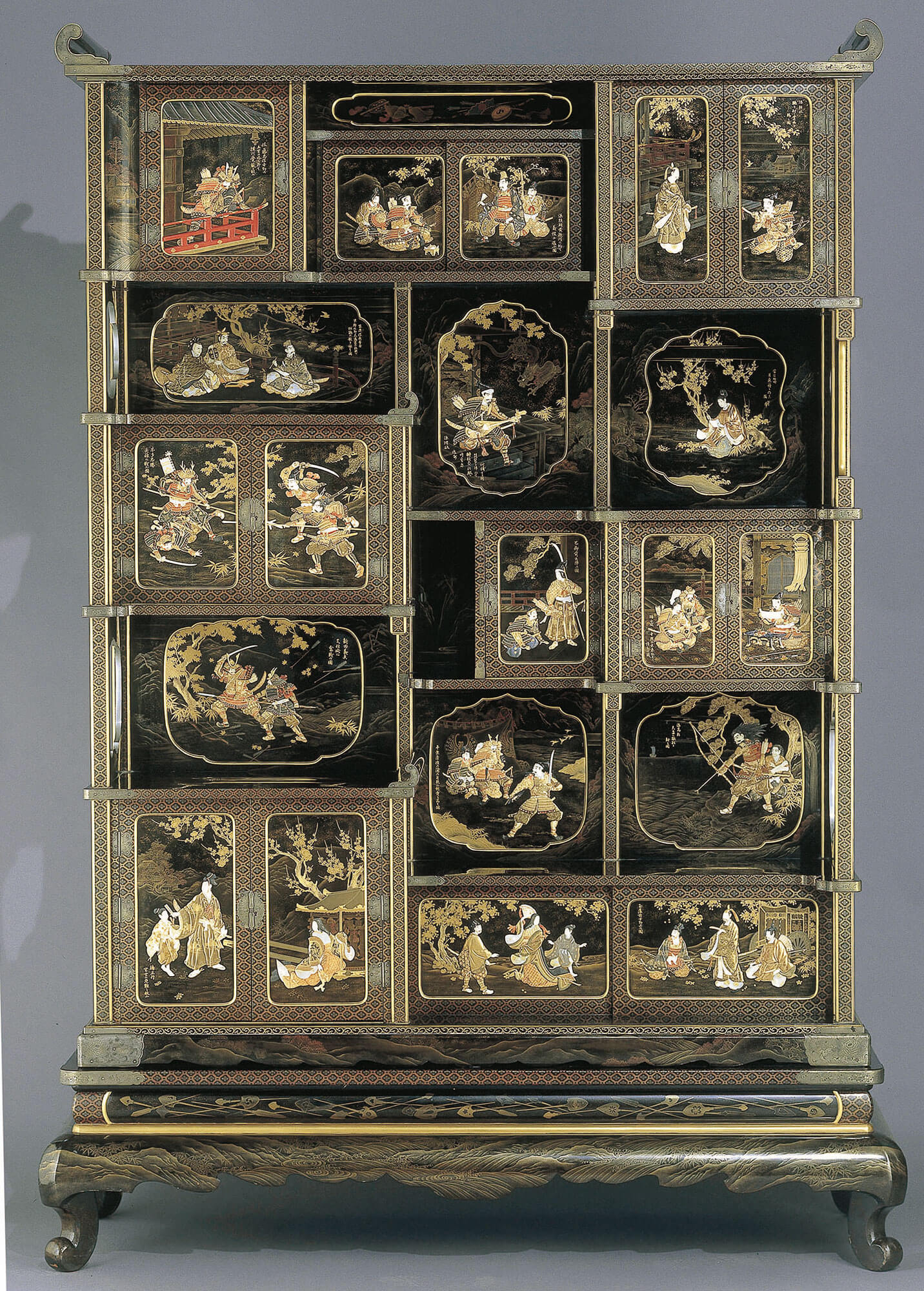
Location: Japan
Materials: Wood, lacquered in hiramaki-e, takamaki-e, hirame, nashiji, and Gyobu; silver fittings
Dimensions: 156 x 16 x 63.2 cm
Accession Number: LX37
Other Notes:
Produced by the Samurai Shokai Company.
The sumptuous decoration of this cabinet shows how traditional lacquer styles were thriving at the very end of the Meiji Era. An accompanying letter claims that the cabinet was made in Japan for the Japan-British Exhibition as a representative piece of Japanese craftsmanship but was not finished in time for shipment to England.
It was purchased in Japan in 1910-11 from “Samurai Shokai, Art dealers, Tokio, Yokohama.” The Samurai Shokai of Kanagawa (i.e. Yokohama), recorded as having won a gold prize for a group of metalwork pieces shown at the Japan-British Exhibition, was a well-known company boasting “a most extensive collection of antique porcelains, bronzes, silver, lacquer wares, and embroideries and new curios of every description.”
Bibliography:
Earle, Joe (1999). Splendors of Meiji: treasures of Imperial Japan: Masterpieces from the Khalili Collection. St. Petersburg, Florida: Broughton International Inc. ISBN 1874780137 pages 208-209
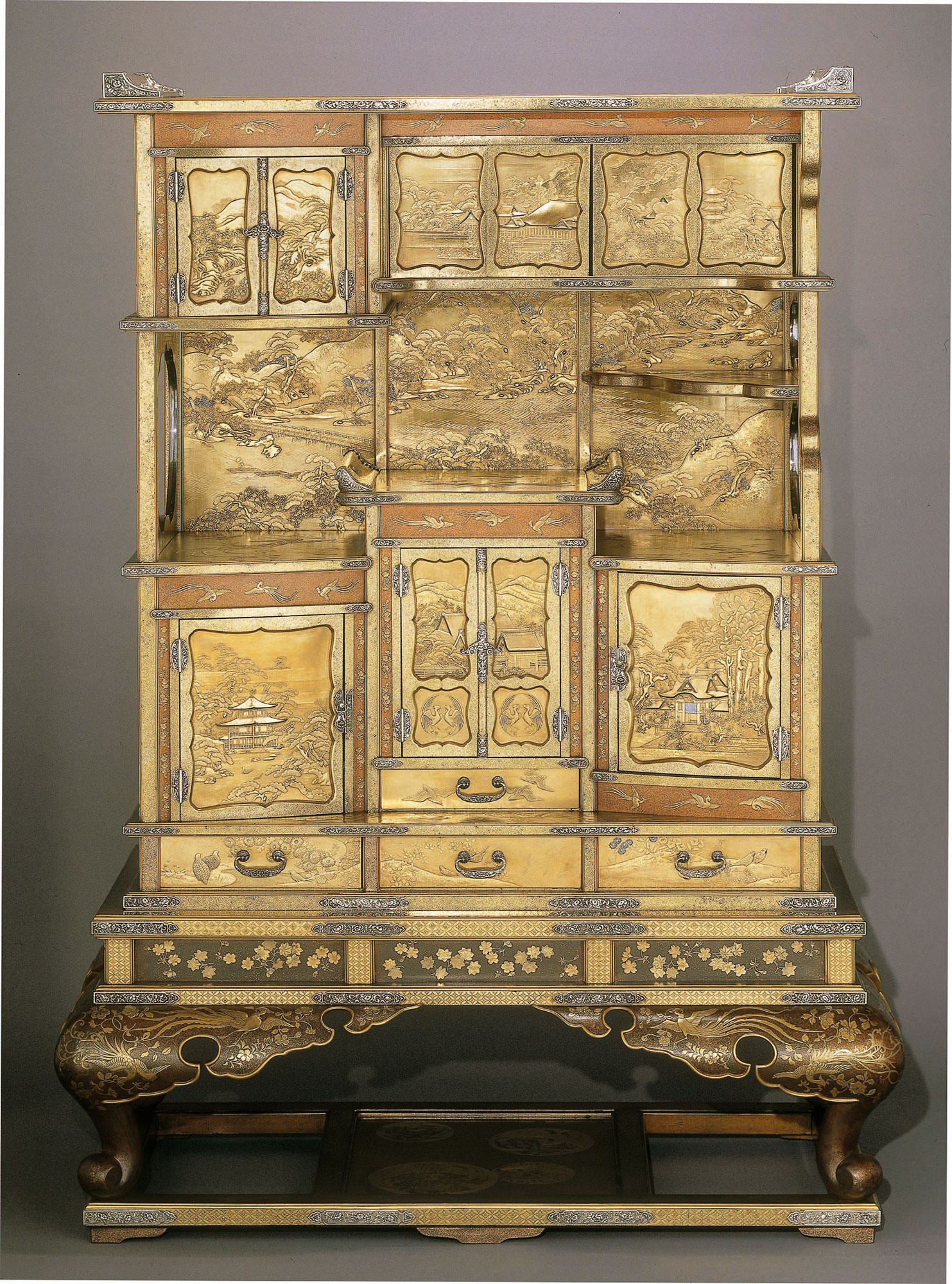
Materials: vellum, 8 folios
Dimensions: 24.2×17.9 cm, written area: 11.9×17.4 cm; 16 or 17 lines per page.
Accession Number: MSS 375
Other Notes: These eight vellum folios consist of two fragments from an Arabic translation of the most influential astronomical treatise prior to the time of Copernicus, the Almagest, which was written in Greek in the 2nd century AD by the Alexandrian astronomer Ptolemy. It was from its Arabic title, al-Majistz, that Ptolemy’s work received the name by which it is generally known today. Four Arabic versions of the treatise were prepared in the 9th century, though only two are extant: that by al-Hajjaj, completed in AH 212 (AD 827-8), and that by Ishaq ibn Hunayn and later revised by Thabit ibn Qurrah in AH 288 (AD gor). The fragments in the Khalili Collection are from the second version, for they correspond, with minor variant readings, to passages in a manuscript preserved now in the British Library, one of only two recorded copies of the second half of that Arabic version.
Bibliography:
Francis Maddison and Emilie Savage-Smith, Science, Tools and Magic. Part One. Body and Spirit, Mapping the Universe, Oxford: The Nour Foundation, 1997, pp. 176–177 (no. 116).
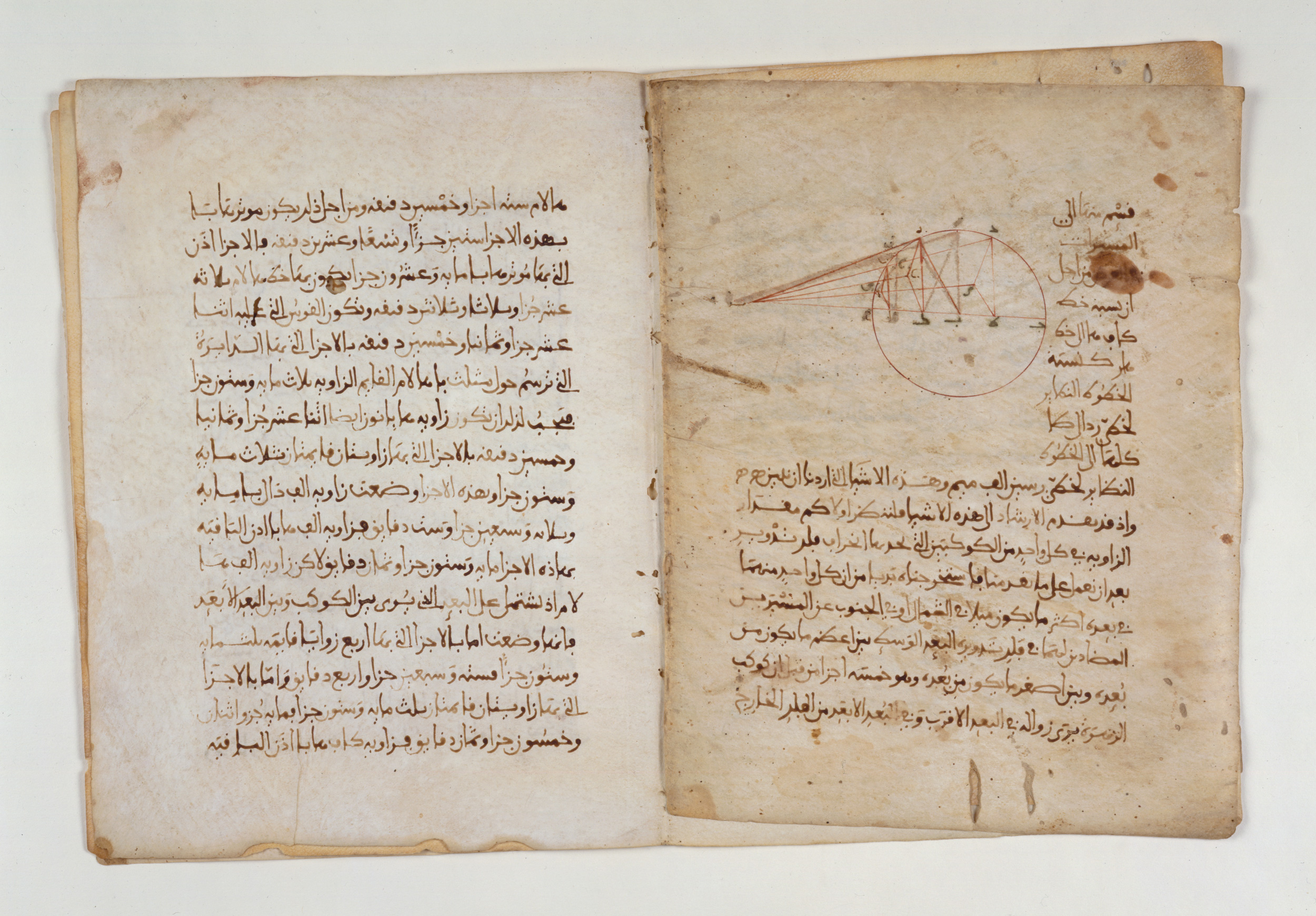
Location: France, Sèvres, the vessel, possibly Burgundy
Materials: rock crystal, silver-gilt and gold with translucent, opaque and painted enamel, cabochon rubies
Dimensions: height 20.8 cm
Accession Number: FR 444
Other Notes:
An inscription on the original design for this covered cup indicates that it was the last object made by Jean-Valentin Morel, prior to his death in 1860. Jean-Valentin Morel was particularly noted for his skill in carving hardstone, and he observed of this activity: “I resolutely set about restoring to the profession of lapidary the importance it had in the hands of the old masters”. As well as interpreting old pieces, or producing replicas, Morel was sometimes commissioned by collectors to provide mounts for antique vessels. The present covered cup is an example of this particular activity.
The Nucleus is a rock crystal ewer of the 14th/15th century, similar in form to another in the Victoria & Albert Museum, London. To this Morel has added a second handle – carved of clearer crystal and, upon examination from the inside, evidently glued to the body of the vessel – and a domed lid. These components are held together by enamelled silver-gilt and gold mounts that are typical of Morel’s evocation of the art of earlier goldsmiths. Stylistically the mounts recall the work of the blanc et vert atelier that flourished in Paris during the mid-17th century. More particularly, the foliate border and satyrs’ masks appear to have been inspired by a ewer originally in the collection of Louis XIV and now in the Louvre.
Bibliography:
Haydn Williams, Enamels of the World: 1700-2000 The Khalili Collections, London 2009, cat. 231, pp. 334–5.
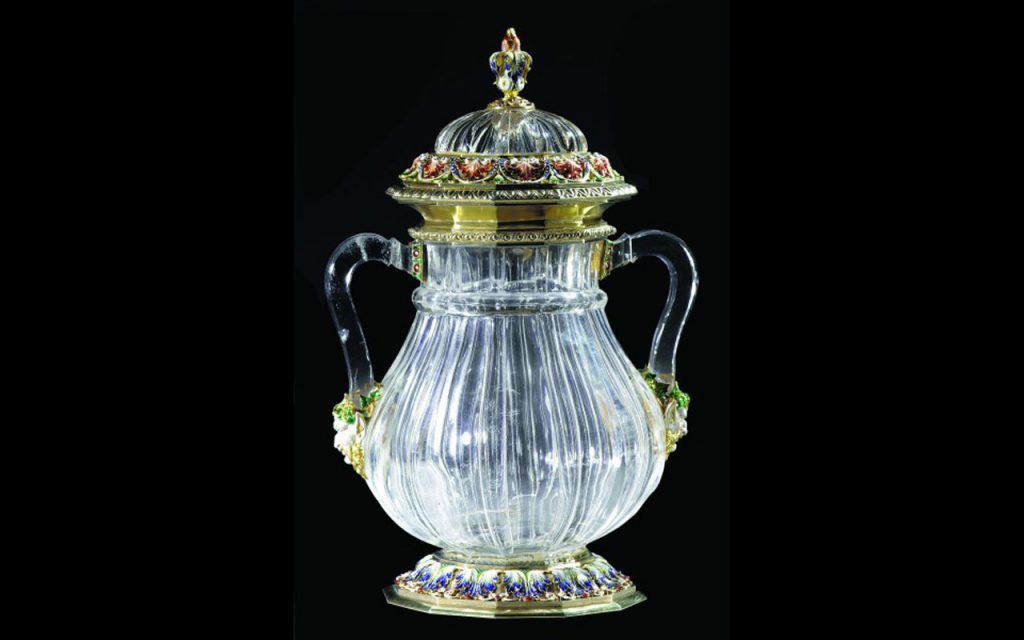
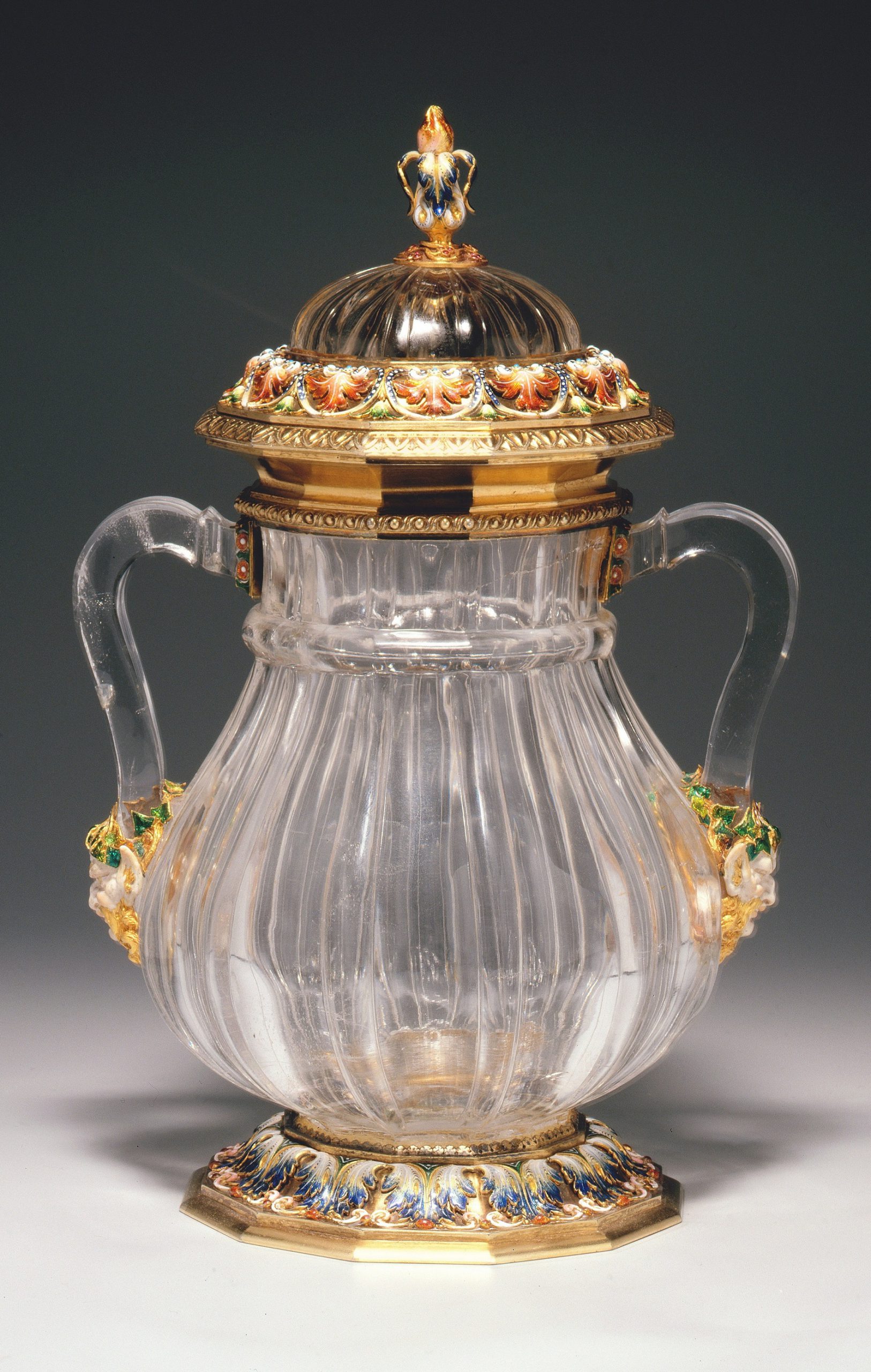
Location: Tabriz, Iran
Materials: ink, gold and opaque watercolour on paper; margins heavily sprinkled with gold
Dimensions: 47.2 x 32.1cm (folio); 27.1 x 17.4cm (written surface, recto); 37.4 x 17.5cm (maximum; illustration, verso)
Accession Number: MSS 1030, folio 38
Other Notes:
Zahhak slays the sacred cow Barmayah, whose holy milk had nourished the infant Faridun, and all the other animals in sight.
[For the Shahnamah of Shah Tahmasp, see MSS 1030]
Script:
text copied in a superior nasta‘liq script, generally with 22 lines to the page, arranged in 4 columns, two to a couplet
Bibliography:
J.M. Rogers, The Arts of Islam. Masterpieces from the Khalili Collection, London 2010, cat.301, p.265.
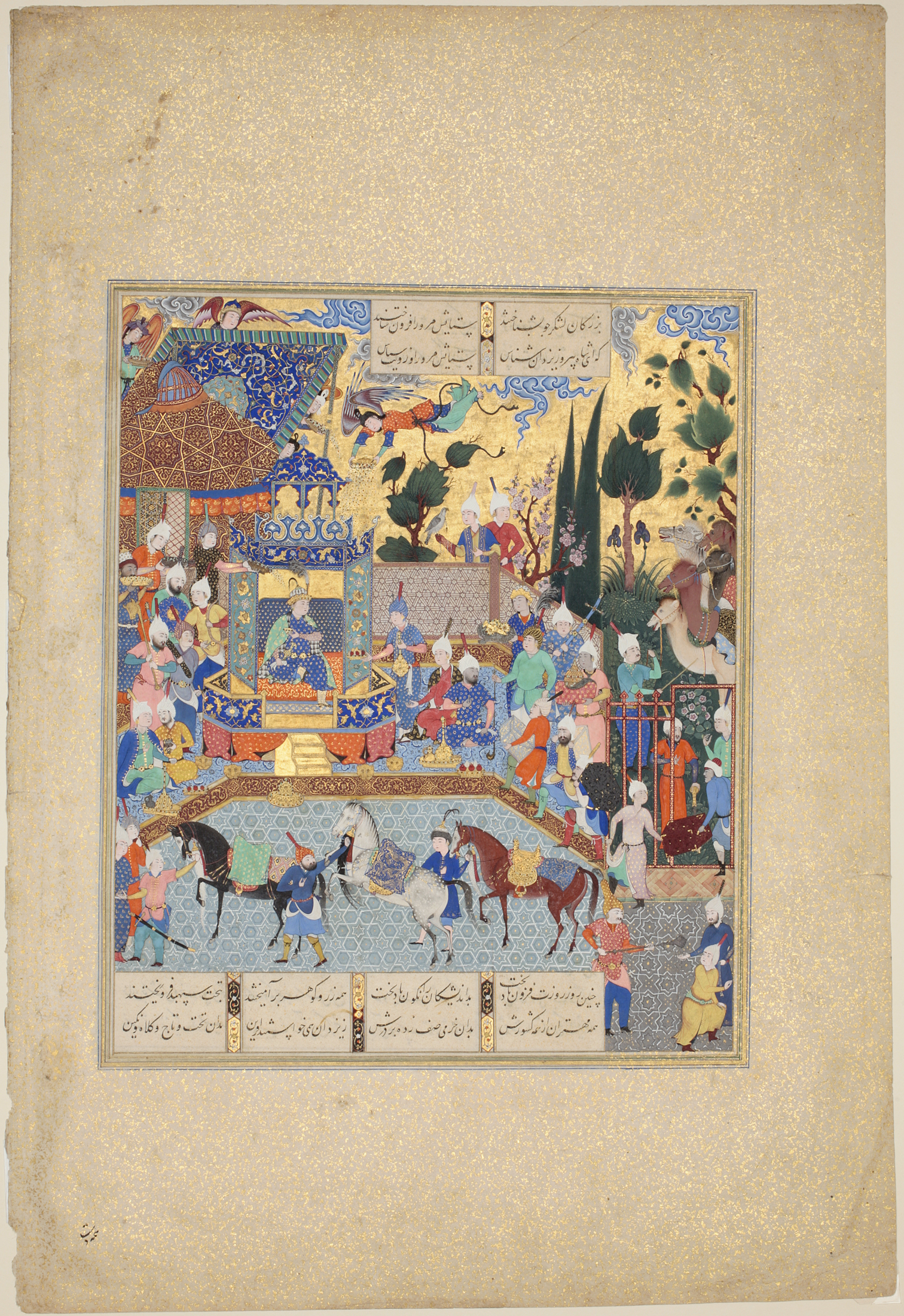
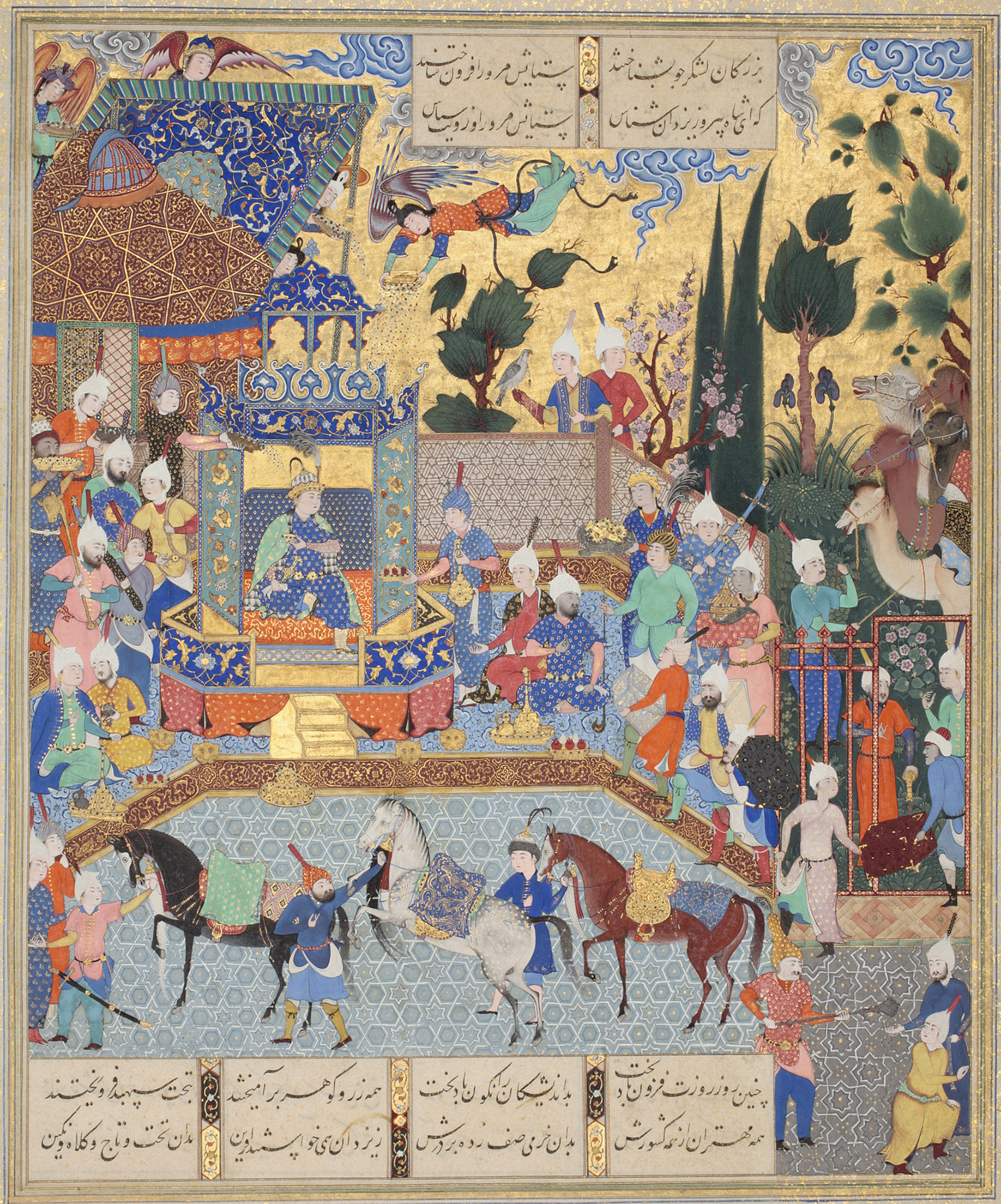
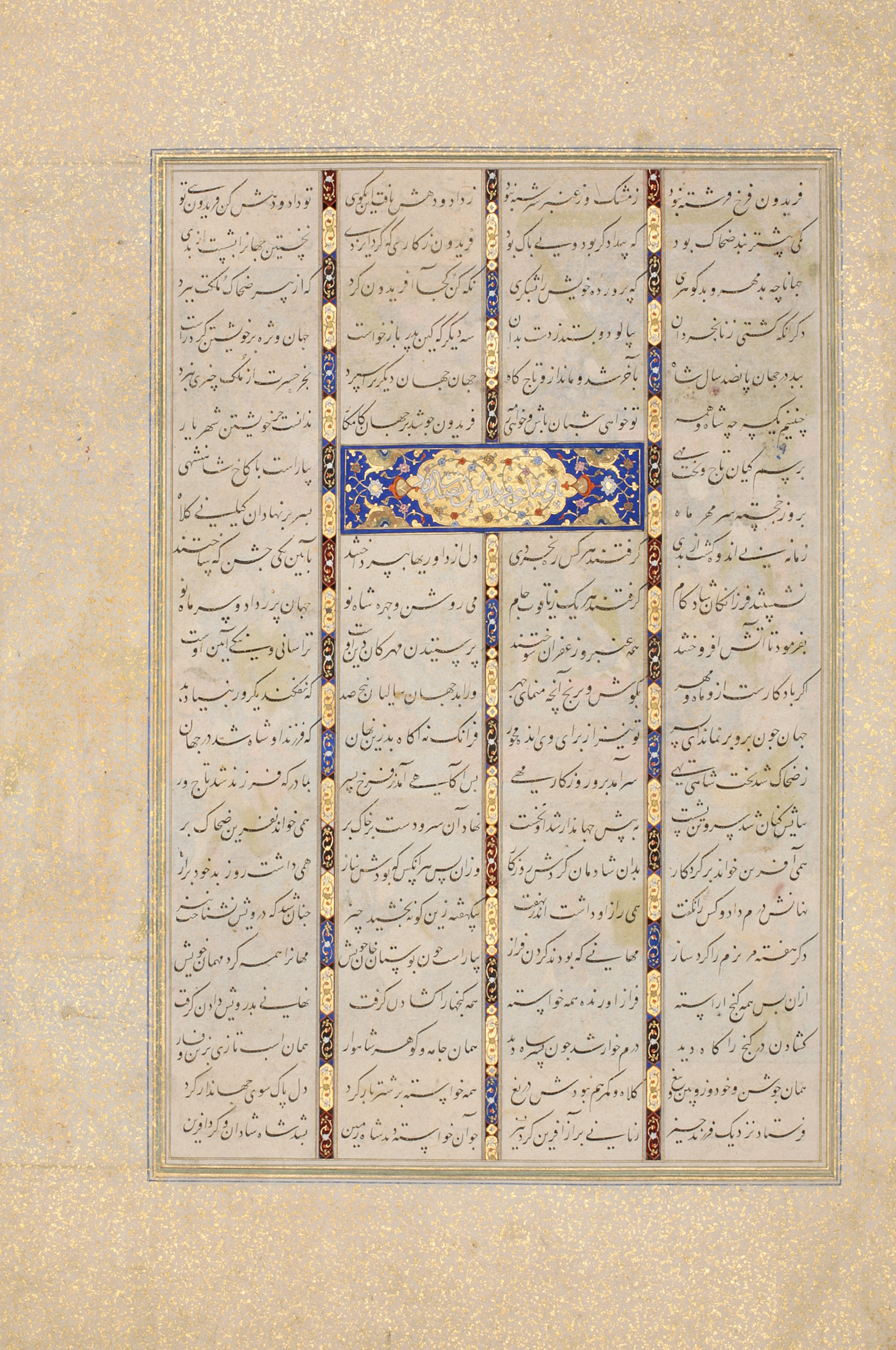
Location: Iran, Khurasan
Materials: quaternary copper alloy, beaten, engraved and inlaid with silver; handle cast
Dimensions: 36 x 16.5cm
Accession Number: MTW 1549
Other Notes:
The ewer is principally decorated with inscriptions, all benedictory – on the fluted body, the shoulders and the neck – and with cartouches with a crescent moon. The neck bears two sitting lions with their right forepaws raised, worked in repoussé, and on the spout is a lion couchant.
Bibliography:
J.M. Rogers, The Arts of Islam. Masterpieces from the Khalili Collection, London 2010, cat.106, p.98.
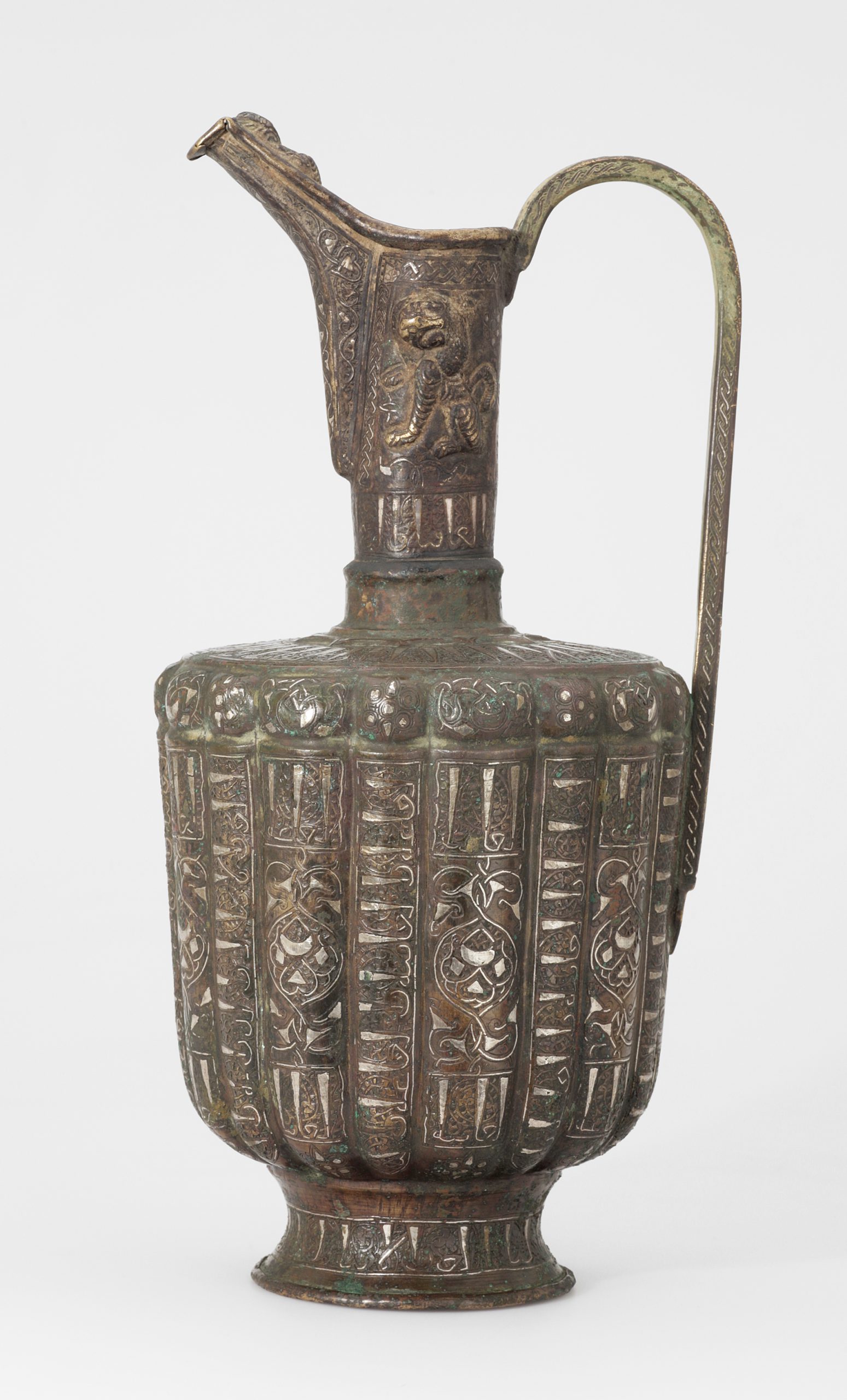
Location: Mughal India
Materials: gold sheet, set with carved Colombian emeralds and a faceted diamond in gold kundan, with an enamelled base
Dimensions: 4 x 5cm
Accession Number: JLY 1857
Other Notes:
This sides and lid of this spectacular gold box are set with 103 emeralds, perfectly matched and fitted. They are carved in shallow relief to depict cypress trees within borders of repeated stylized leaves. The precious materials and the high quality of the design and craftsmanship suggest that the box was made at the highest level of Mughal court patronage.
Each of the 16 slightly convex rectangular panels that make up the wall of the box is composed of two or more emeralds and is carved with a cypress with its tip curving to the left. The triangular panels on the cover are each composed of three or four pieces of emerald and are also carved with cypresses. The stones are held in place by narrow bands of gold, which also define the panels. The vertical bands are decorated with a sharply chiselled zigzag motif. At the apex of the lid is a diamond. It has an octagonal table surrounded by 24 visible facets within the girdle and appears to represent an early form of brilliant cutting.
The underside of the box is covered with emerald-green enamel over engraved decoration. The pattern consists of a central rosette surrounded by two rows of stems with split acanthus leaves forming pairs of double scrolls. The ground is hatched and cut away so that the enamel is darker in the background and lighter over the rosette and scrolls. The decoration suggests European influence, which presumably came into Mughal court art during the first half of the 17th century with the European craftsmen in the service of Jahangir and Shah Jahan. It is possible that the designs were influenced by engravings from the studio of Bernard Salomon who worked at Lyons in the mid-16th century.
Bibliography:
P. Moura Carvalho, Gems and Jewels of Mughal India. Jewelled and enamelled objects from the 16th to 20th centuries, The Nasser D. Khalili Collection of Islamic Art, volume XVIII, London 2010, cat.11, pp.68–9.
J.M. Rogers, The Arts of Islam. Masterpieces from the Khalili Collection, London 2010, cat.423, pp.354–5.
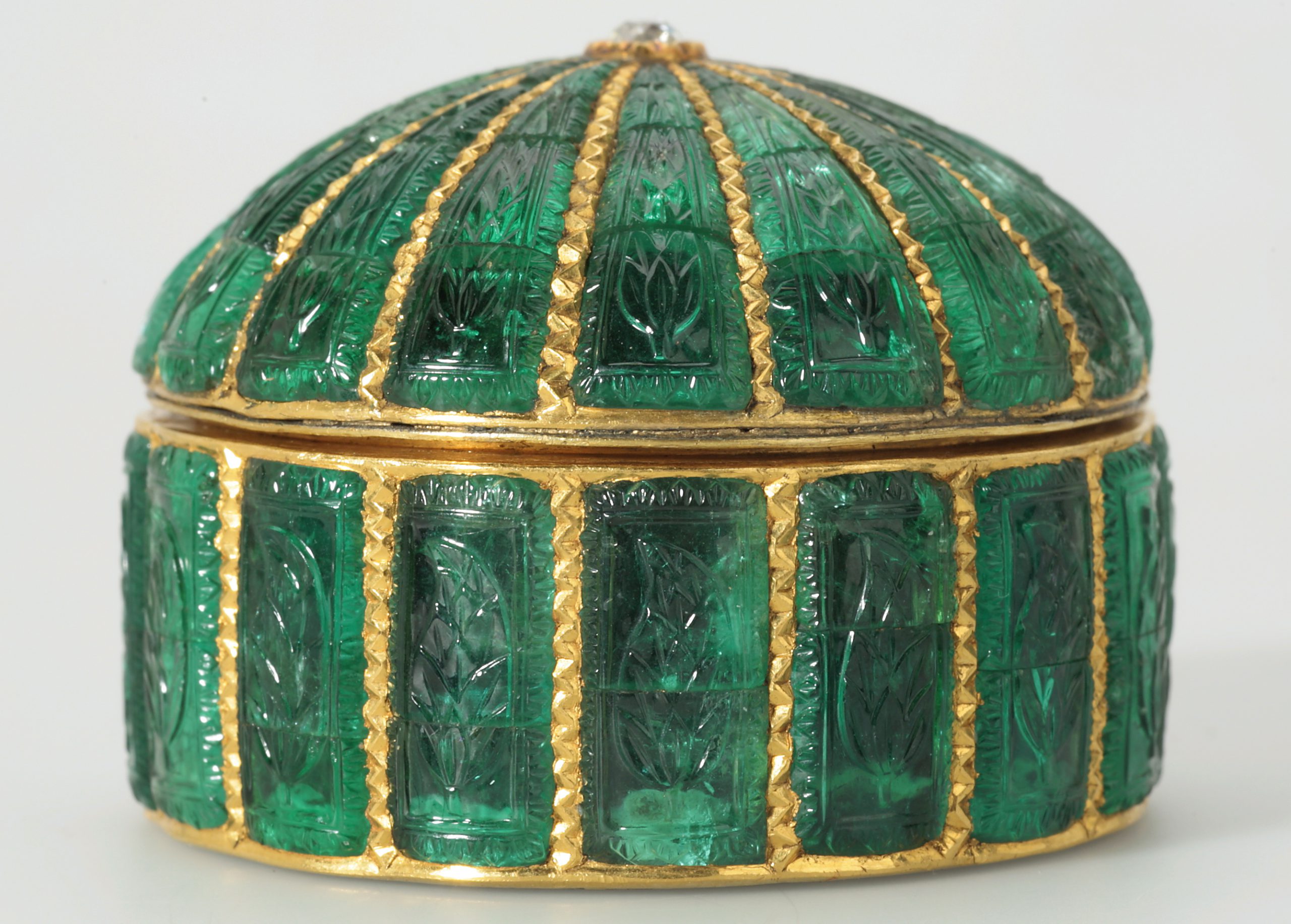

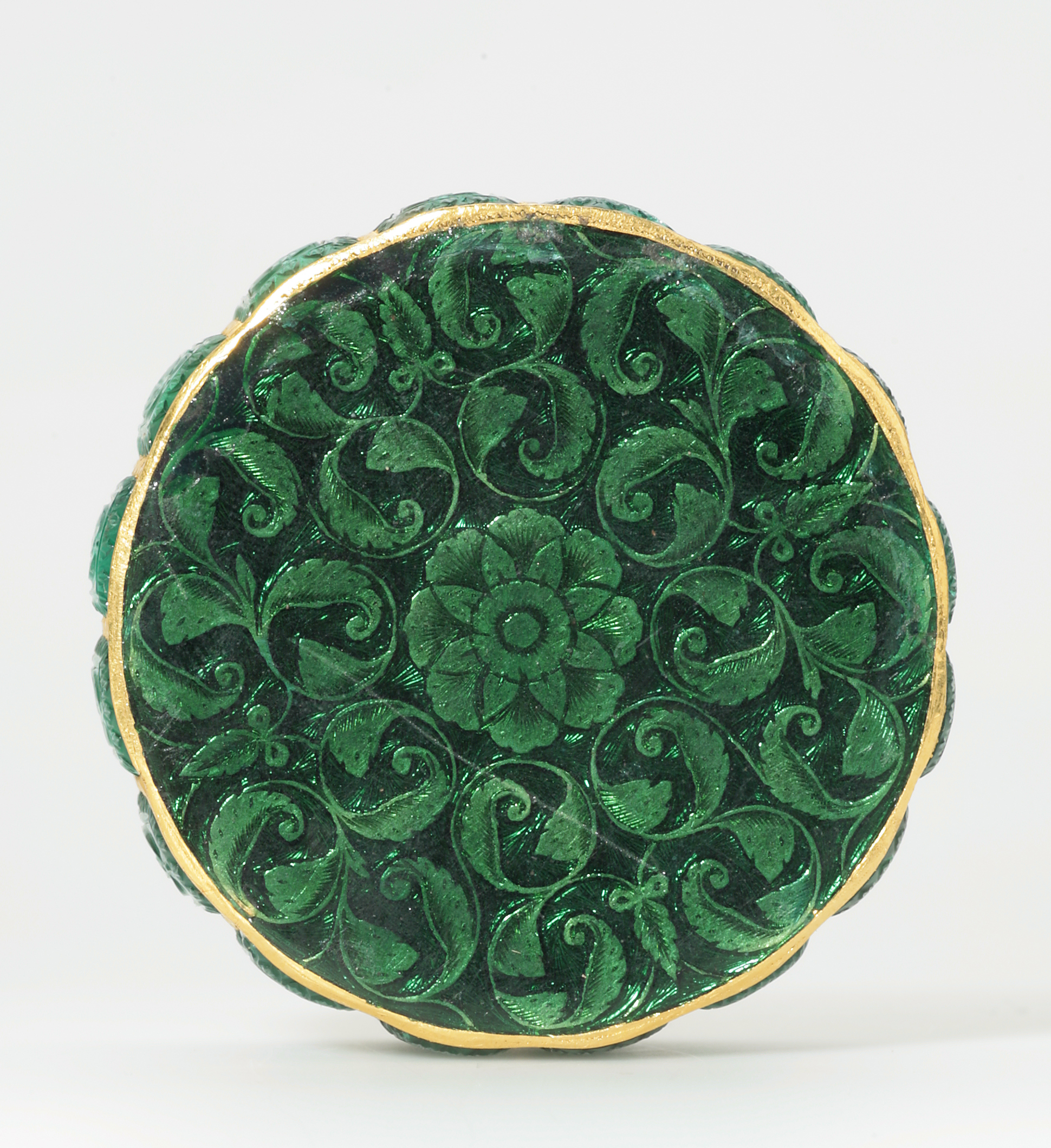
Date: 1870-1871
Location: Spain, Eibar
Materials: forged iron and chiseled and engraved iron repoussé, silver with niello, gold and silver damascening
Dimensions: 121 x 201 x 86 cm
Accession Number: ZUL 102
Other Notes:
The four vertical faces and the top have repoussé ornament executed in high relief in seventeenth-century baroque design depicting winged putti amid animal and vegetal grotesques. The large front panel is divided into two halves, the right being the mirror image of the left. The decorated plates were blued prior to the application of gold leaf to the stippled background. Small details of gold damascene decorate the relief images, visually uniting them with the surrounding gold ground.
A damascened border with raised mouldings frames the panels, and in each corner is set a damascened iron boss. Such bosses, in iron and also in lapis, are a continuing feature of Plácido's work. The pronounced overhangs of the casket’s lid and identical skirt have a relief-chiselled acanthus border. Flattened bun feet raise the casket from the floor.
The entire interior is decorated in white painted enamel with black ornament repeating in silhouette the baroque style of the exterior panels. A large forged and chiselled iron lock and hasp with its baluster-shaped hinge completes the casket's decoration. Two identical hinges are affixed to the rear of the lid.
Centred on the rear vertical iron plate, and surrounded by baroque ornament, is a large cartouche containing the following inscription in block capital letters:
ENCARGO DE EL S.D. ALFRED MORRISON Y EJECUTADO POR PLACIDO ZULOAGA EN EIBAR AÑO 1870 Y 1871 (‘commissioned by S[eñor] D[on] Alfred Morrison and executed by Plácido Zuloaga in Eibar, 1870 and 1871)
This enormous iron casket was thus undoubtedly made by Plácido Zuloaga, apparently as his first commission for Alfred Morrison. Although correspondence relevant to its manufacture is extant, it is recorded as being in the drawing room of Morrison's London home at Carlton House Terrace in an 1879 article in the Magazine of Art. Since the cassone has long been known as the ‘Fonthill Casket’, it must originally have been among the furnishings of Fonthill manor, which Alfred inherited upon his father's death in 1857.
The manufacture of this casket would have required a team of specialists working throughout the two years indicated by the inscription. The iron construction would have involved forgers, filers, and chisellers. The final finish would have been executed by damasceners and engravers, who would have completed the exterior and interior detail. Given the importance of this piece, probably a tour de force to ensure Alfred Morrison's continued sponsorship, Plácido would have been directly involved at every step in its manufacture. The grandeur of the concept of what must have been his first major commission for a client outside the royal household prefigures that of Plácido's subsequent great ‘case’ pieces, the Prim mausoleum and the Loiola altar.
Bibliography:
J. D. Lavin (ed.), The Art and Tradition of the Zuloagas: Spanish Damascene from the Khalili Collection, Oxford 1997, cat. 1, pp.70–81.
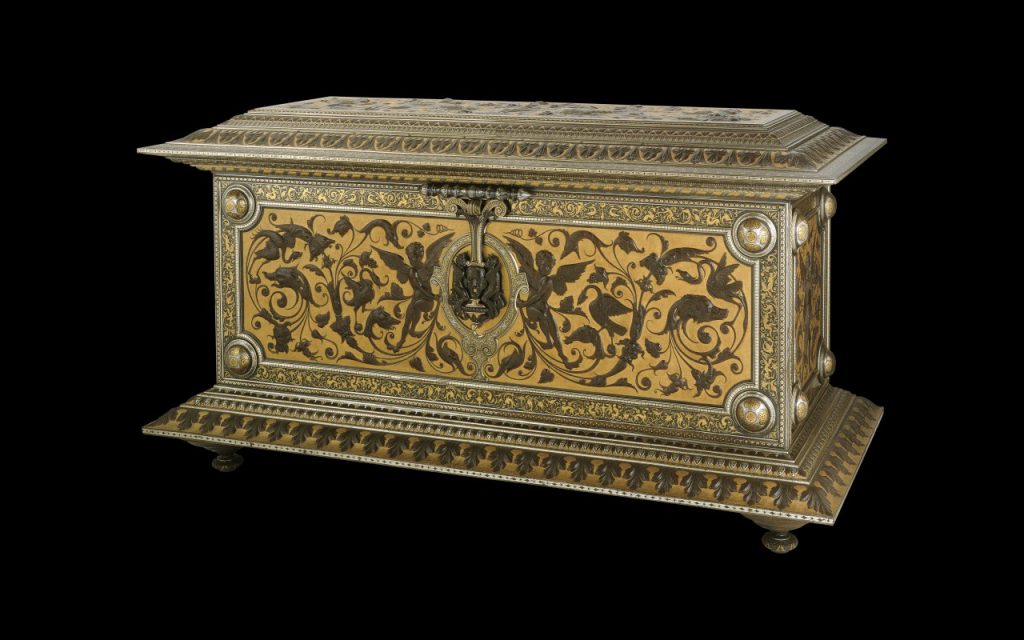
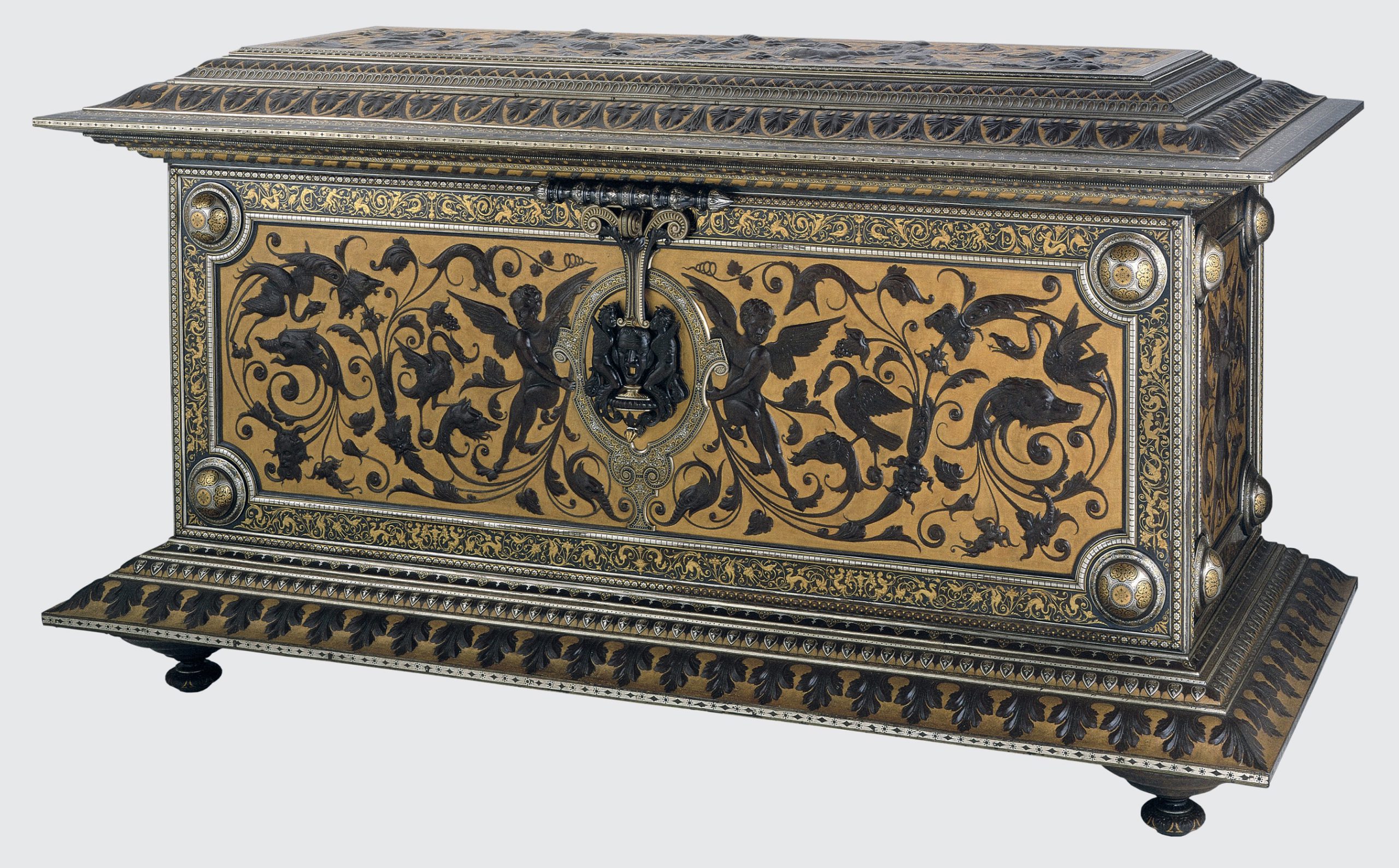
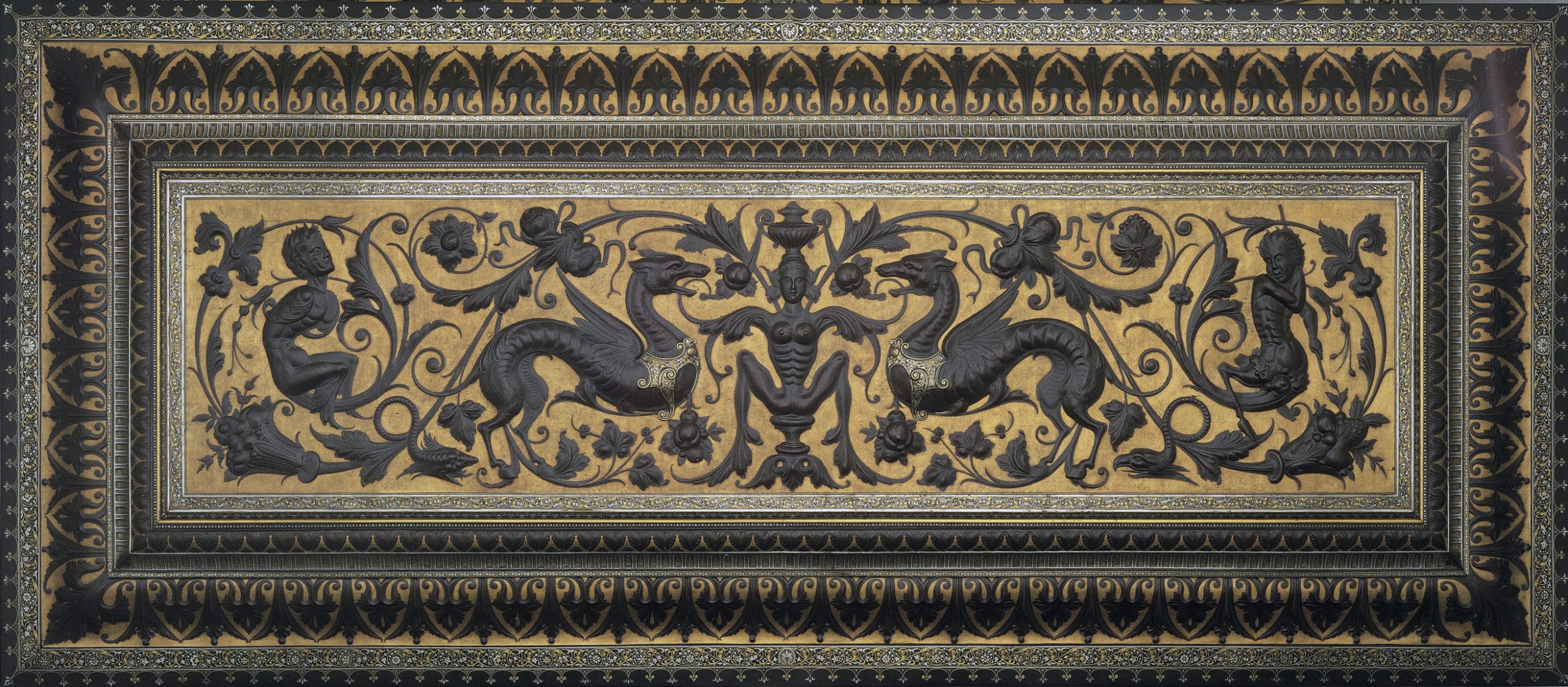
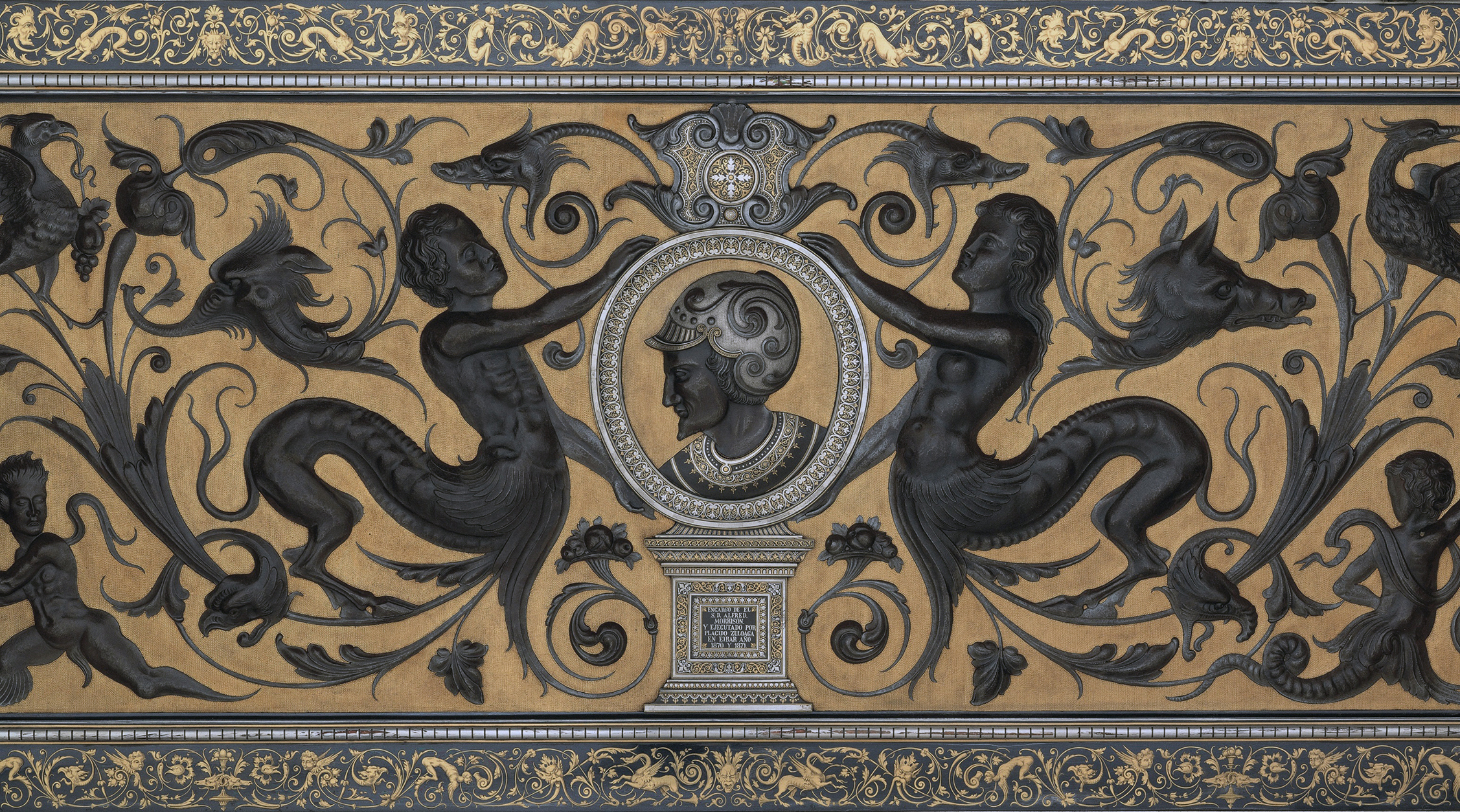
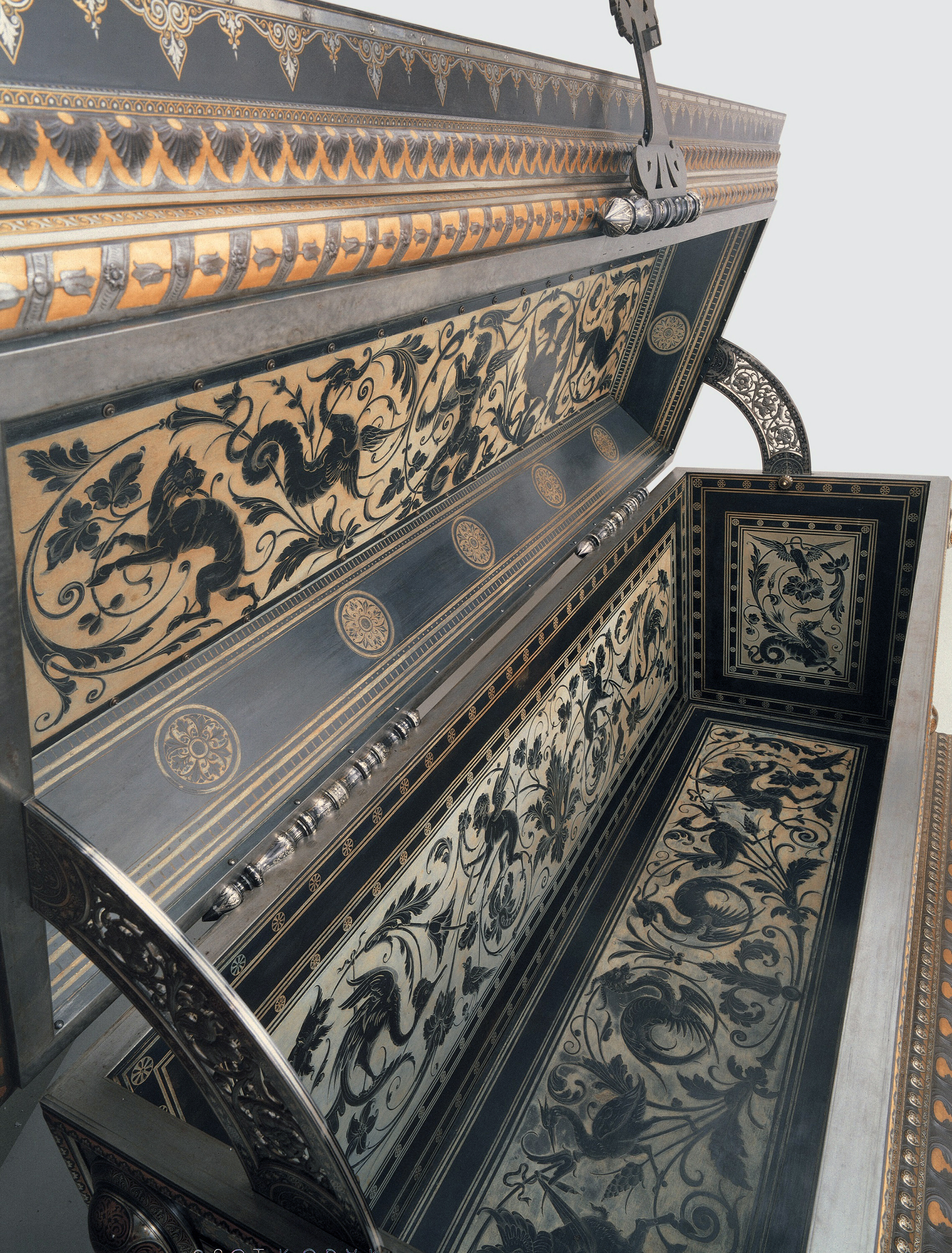
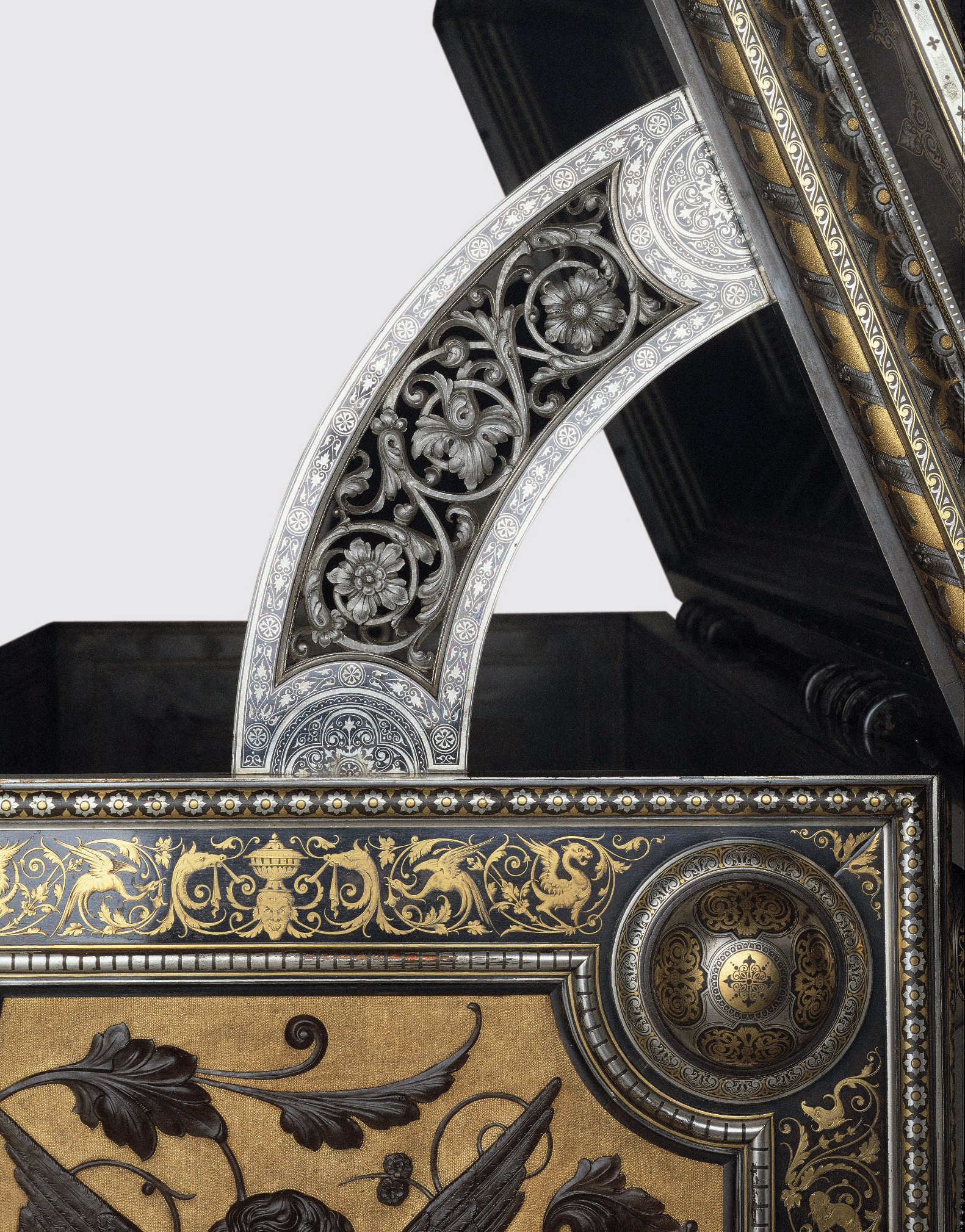
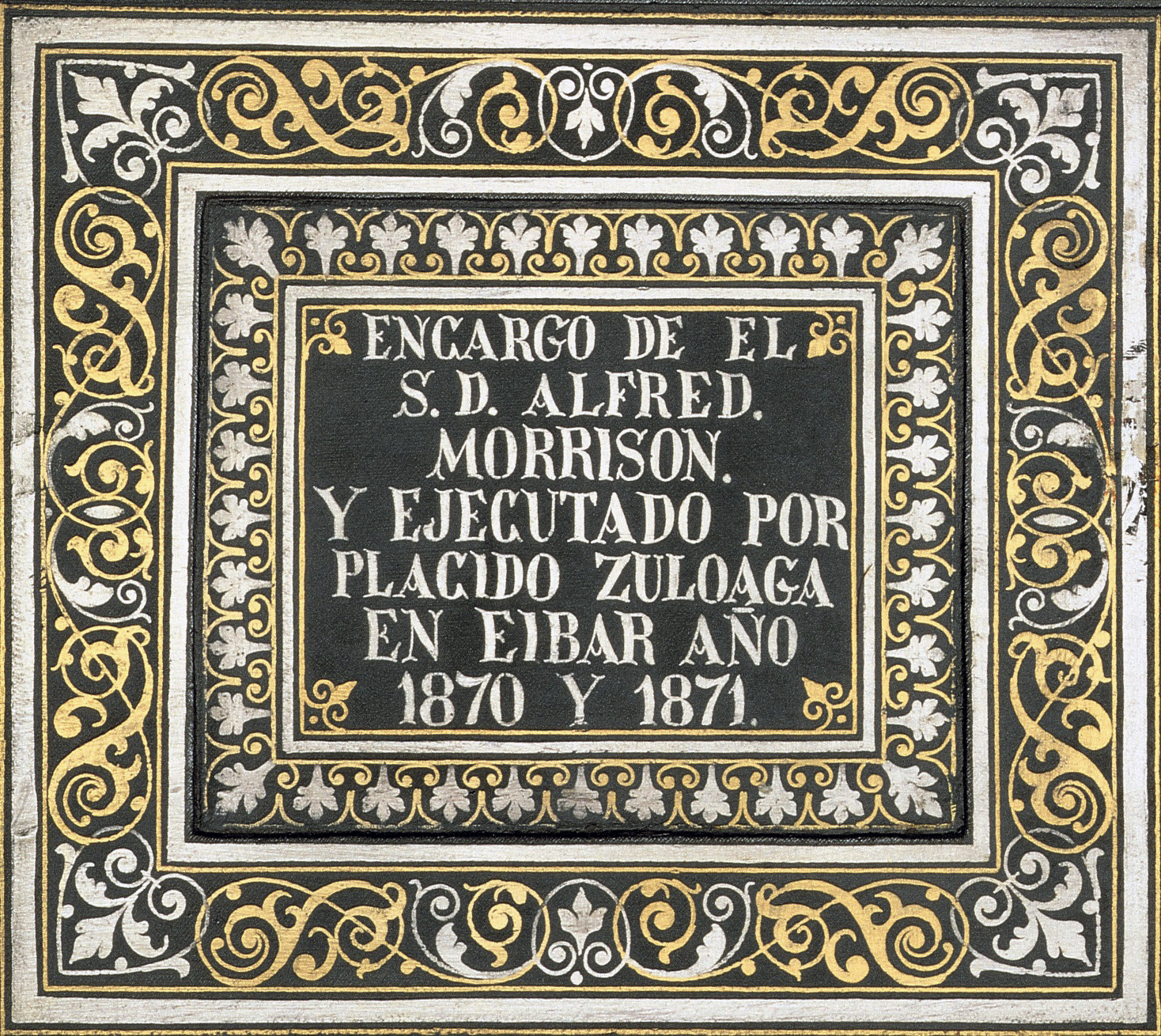
Location: Spain, Eibar
Materials: forged iron, pierced and damascened in gold and silver
Dimensions: height 41 cm
Accession Number: ZUL 92
Other Notes:
This iron vase has its ovoid body flattened and pierced. Its neck, body, and foot, of almost classic simplicity, have their blackened surfaces polished and lightly damascened in foliate patterns in alternating gold and silver. Silver-foil ribbons outline the ornamented areas. The two pierced panels are also ovoid and follow the profile of the body; their foliate ornament is enhanced with gold and silver wire damascene over a finely hatched background. The panels are framed by a border containing baroque foliage also damascened in gold and silver. The applied handles, in the shape of stylized leaves similarly decorated, are attached only at their base.
Bibliography:
J. D. Lavin (ed.), The Art and Tradition of the Zuloagas: Spanish Damascene from the Khalili Collection, Oxford 1997, cat. 5, pp.90–1.
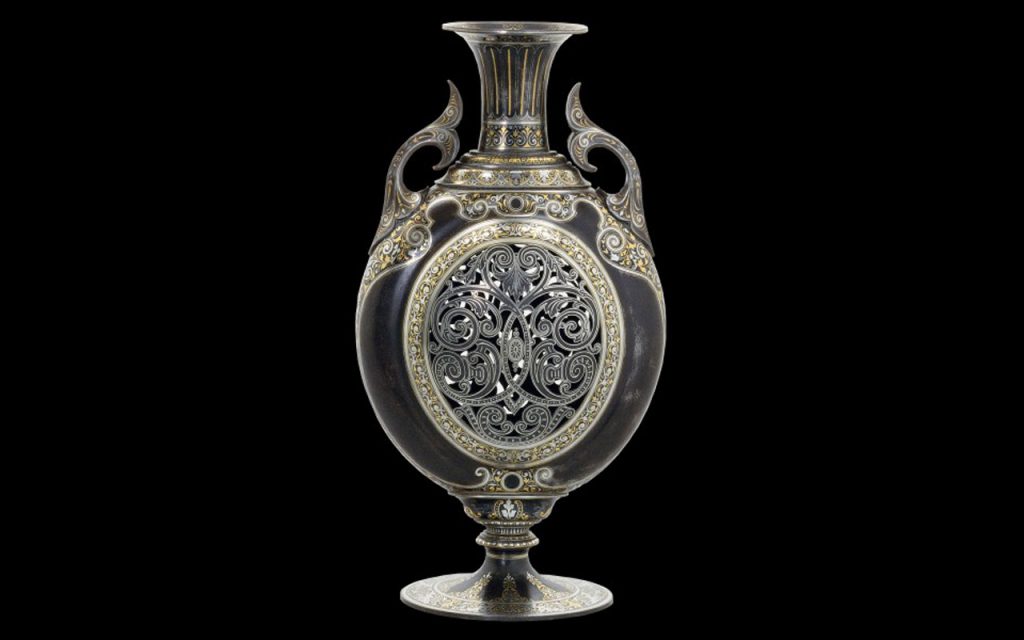
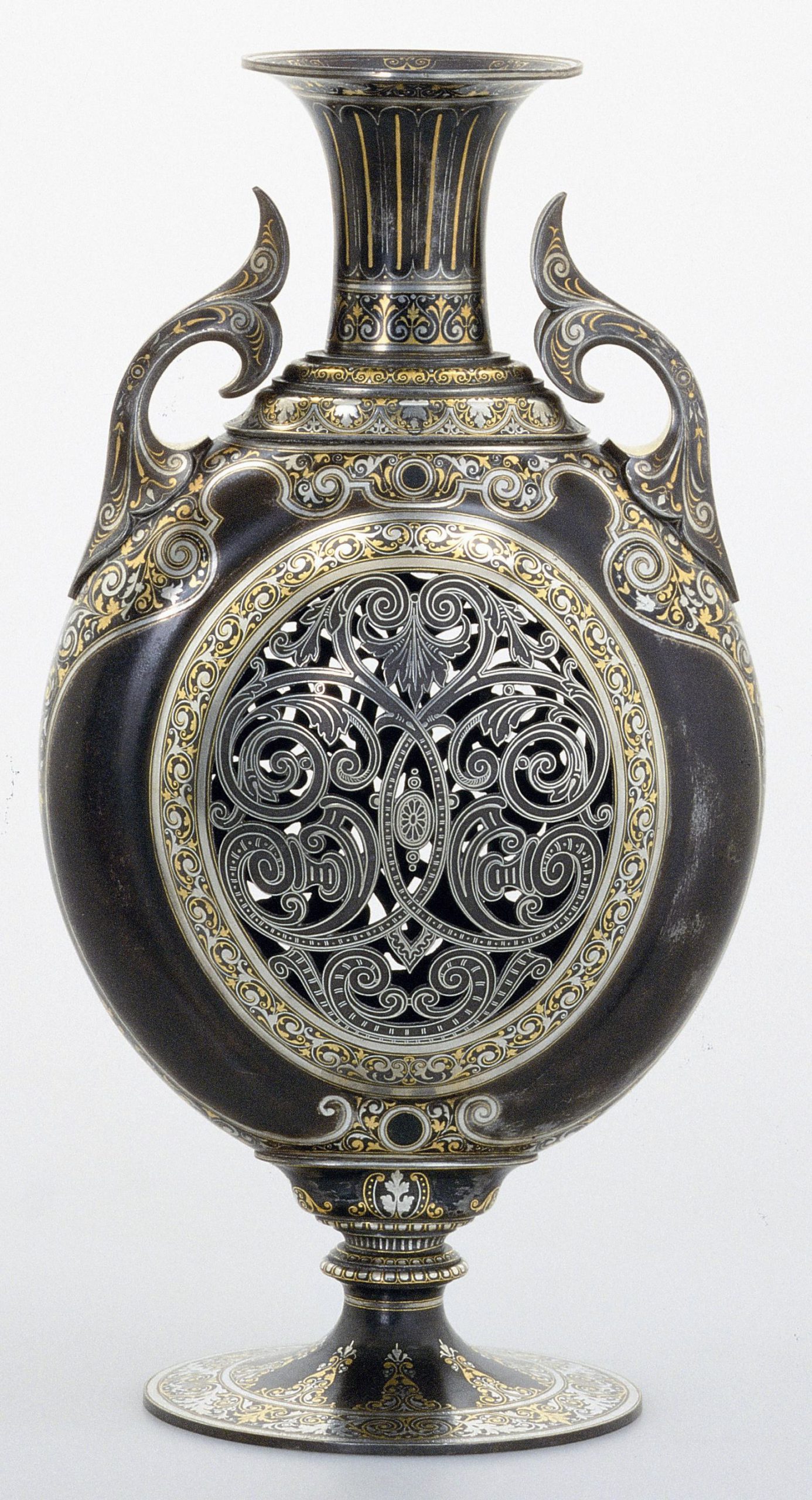
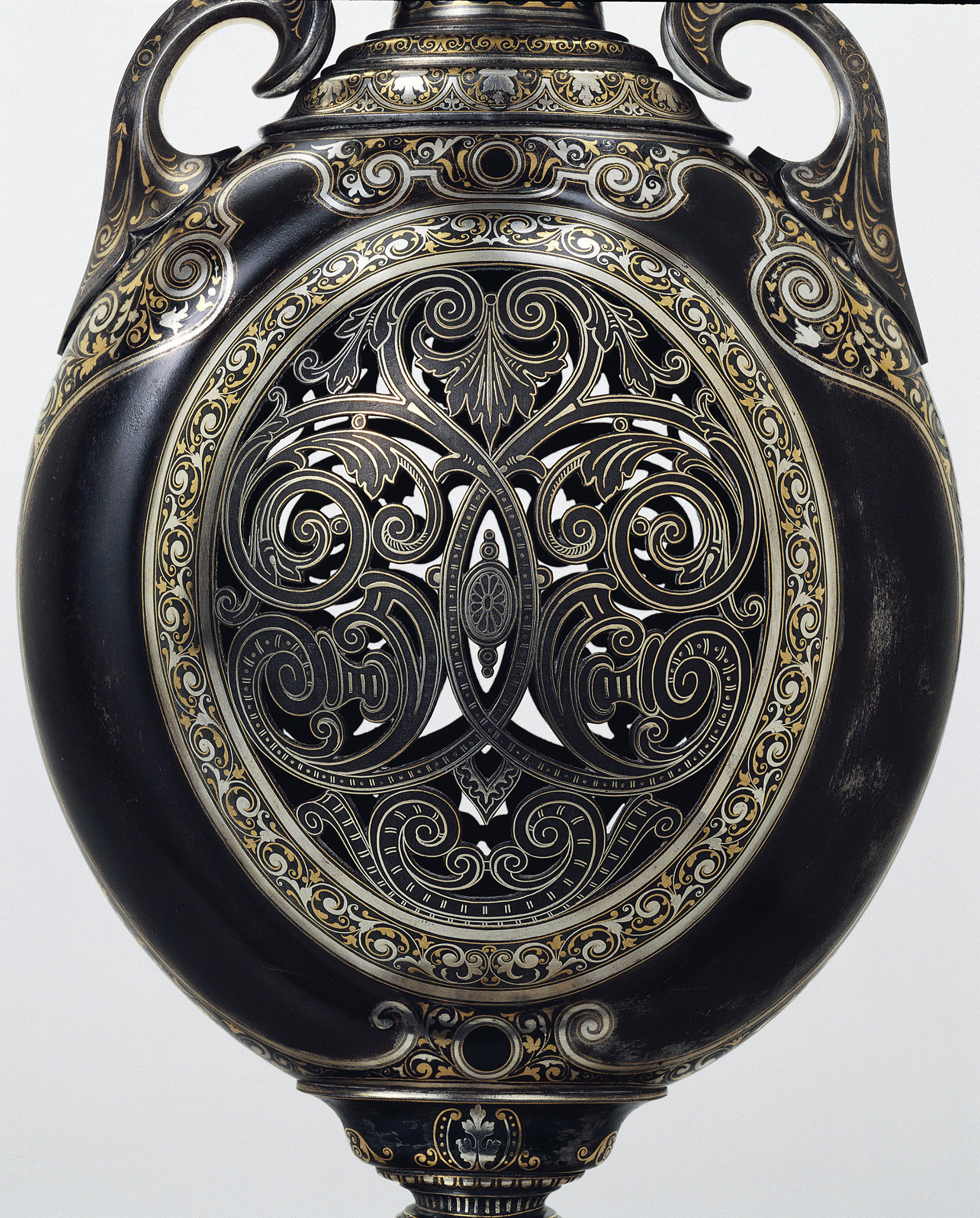
Location: Spain, Eibar
Materials: forged iron, gold and silver damascene
Dimensions: 55.7 x 58 (base) x 22.7 (clock) cm
Accession Number: ZUL 108
Other Notes:
The clock movement is enclosed in a square iron case raised some 25 cm above its base by two decorative wrought-iron supports. The black dial, cross-hatched overall, has an applied gilt-iron sunburst through whose centre pass the arbors for the hands, which are similarly chiselled, pierced, and gilt. Roman numerals in silver-wire damascene indicate the hours. The dial is surrounded by a false chapter ring bevelled inward. To this are affixed eight equally spaced pierced and chiselled bosses, also gilt. Four are placed at the three, six, nine, and twelve positions; the other four are spaced equally between. Since the bosses are much more prominent than the numerals, they can give the confusing initial impression that they are the hour indicators.
Projecting from the four sides of the clock case are pierced and gilt iron appliqués in the form of scrolled broken pediments. The front surface of each of the case’s corners is damascened in gold and outlined with a fine silver wire, as on the brooch ZUL 135. In the centre of each of the corners is a damascened oval plaque containing a cross, another common ornamental element in Plácido’s repertoire.
The wrought-iron supports for the clock are square in section and terminate at both ends in a tight spiral. Applied to them are ten gilded sheet-iron acanthus leaves. The pendulum weight is fully visible between the supports. It is chiselled in relief in the shape of an inverted anthemion capped with a C-scroll and flanked by chiselled acanthus leaves.
The vertical sides of the wide iron base angle inward towards their top. The corners of what would otherwise be a rectangular base are clipped, thus dividing the vertical portion into eight flat surfaces. To these are applied twelve round and oval bosses patterned like those around the false chapter ring. Seven more identical bosses are applied to the upper face of the base, including a large oval directly below the pendulum.
The entire base is damascened in silver and gold wire in patterns almost identical to those on the signed casket ZUL 3. No maker’s mark appears on either the clock’s case or its base, although the plate from the underside of the base, its expected location, is missing. However, the extensive use of elements of Plácido’s decorative vocabulary, and their execution in heavy wire damascening unadorned with punch decoration, strongly indicate the involvement of this master or his workshop in this clock’s construction.
Bibliography:
J. D. Lavin (ed.), The Art and Tradition of the Zuloagas: Spanish Damascene from the Khalili Collection, Oxford 1997, cat. 23, pp.116–9.
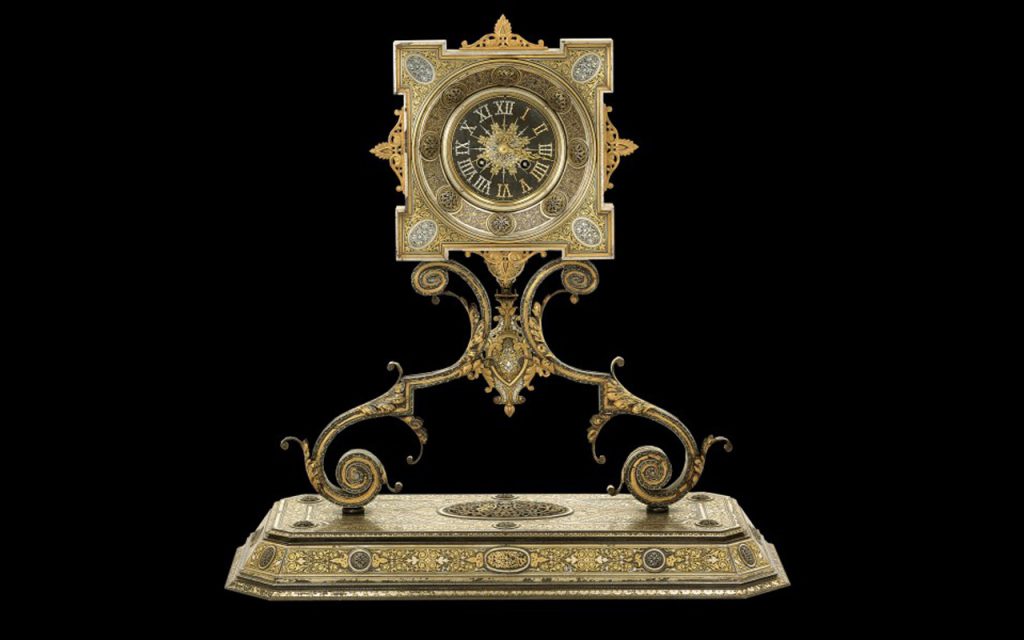
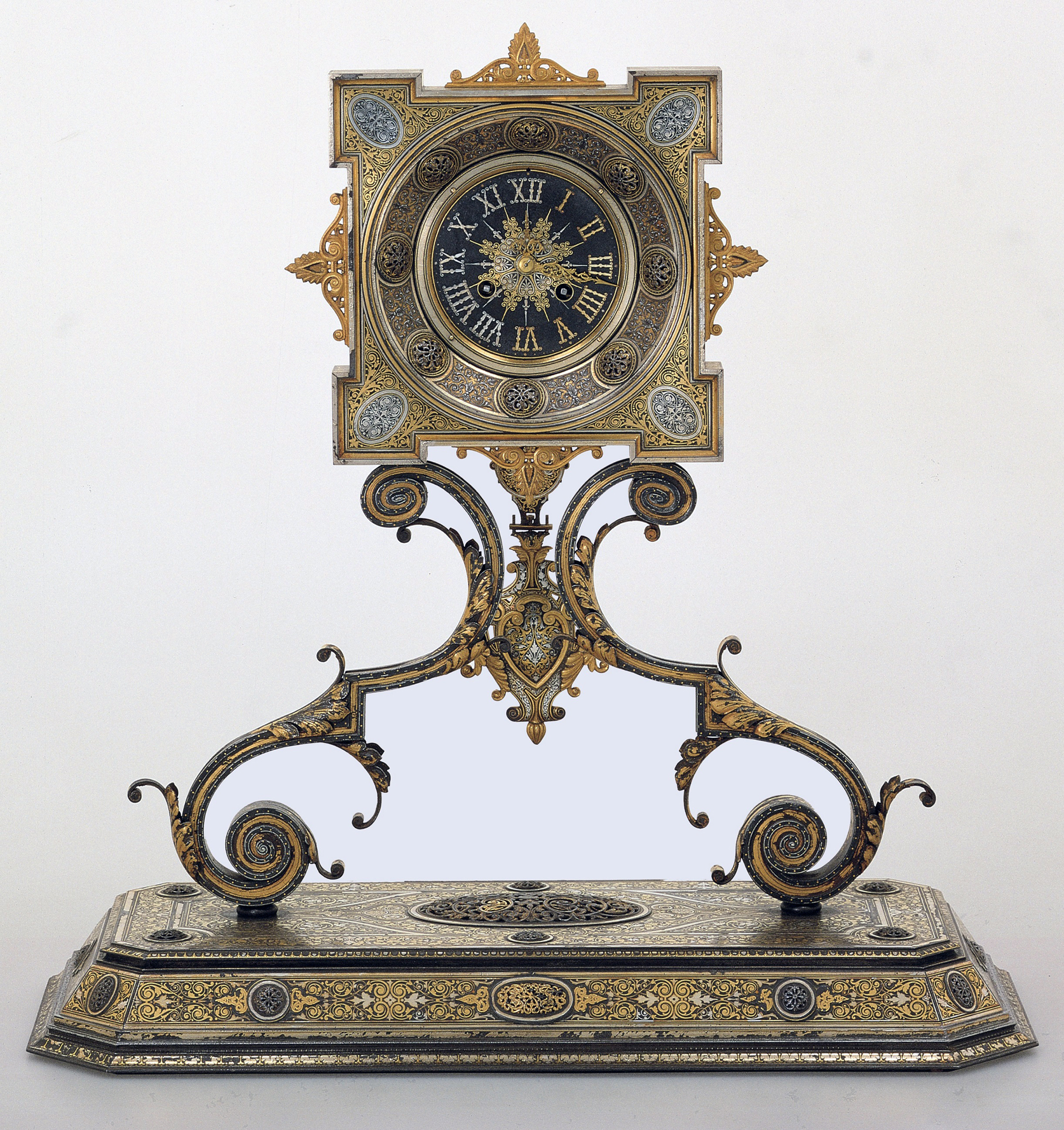
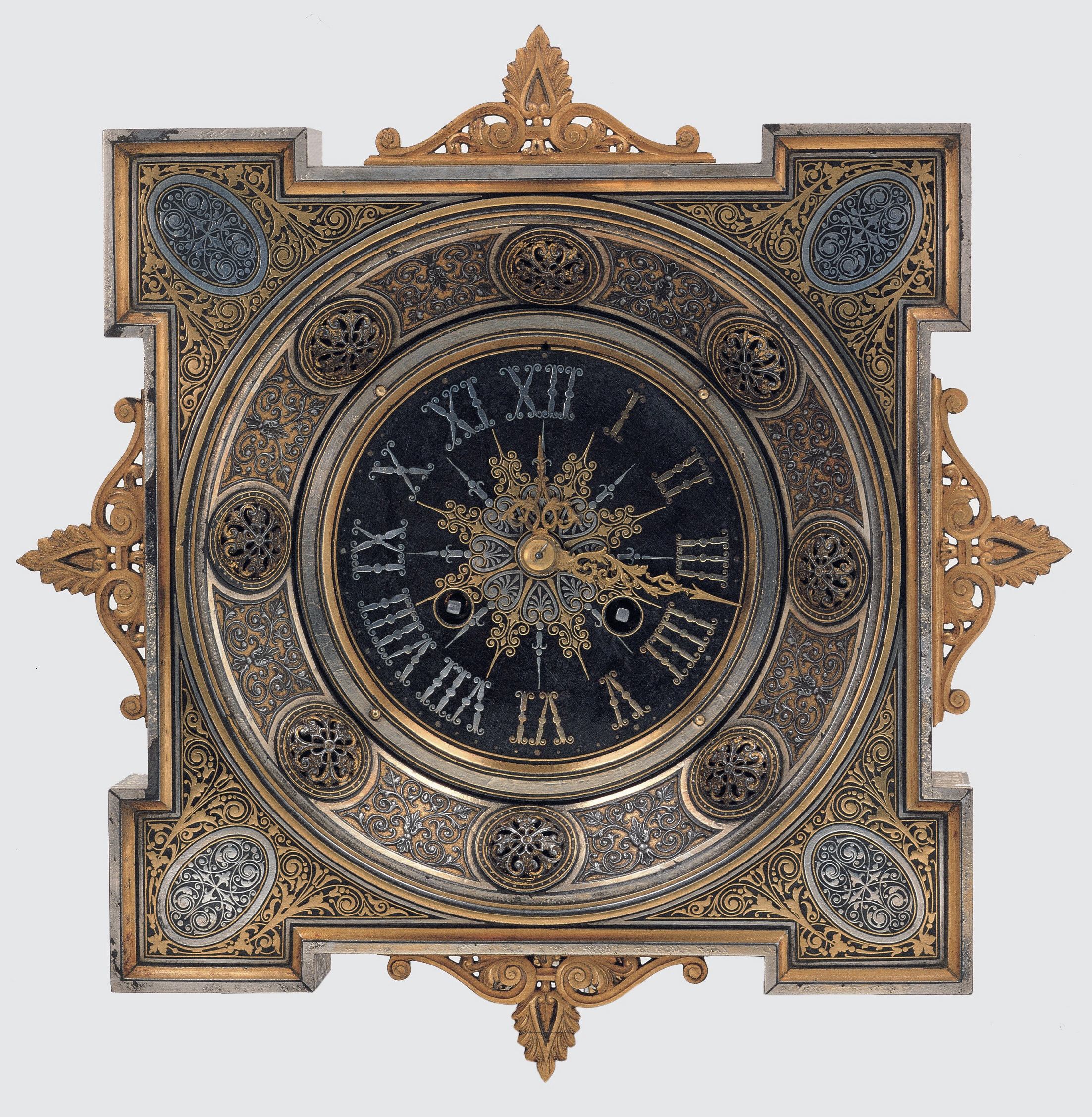
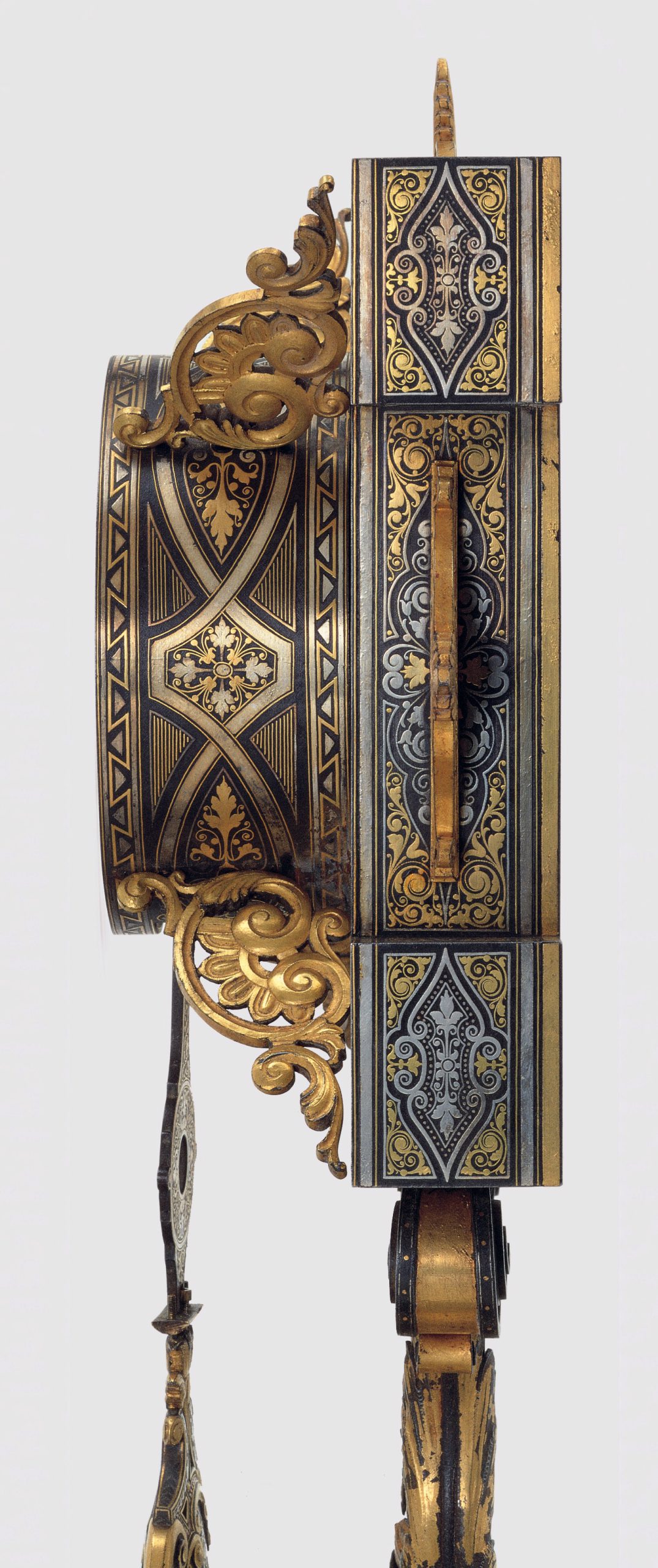
Location: Russia, St. Petersburg
Materials: Silver-gilt, translucent and opalescent enamel, seed pearls
Dimensions: 18.2 x 8.5 x 4.3 cm
Accession Number: FAB 96
Other Notes:
88 zolotniks
inventory number (?)539
Bibliography:
Haydn Williams, Enamels of the World: 1700-2000 The Khalili Collections, London 2009, cat. 264, p. 384.
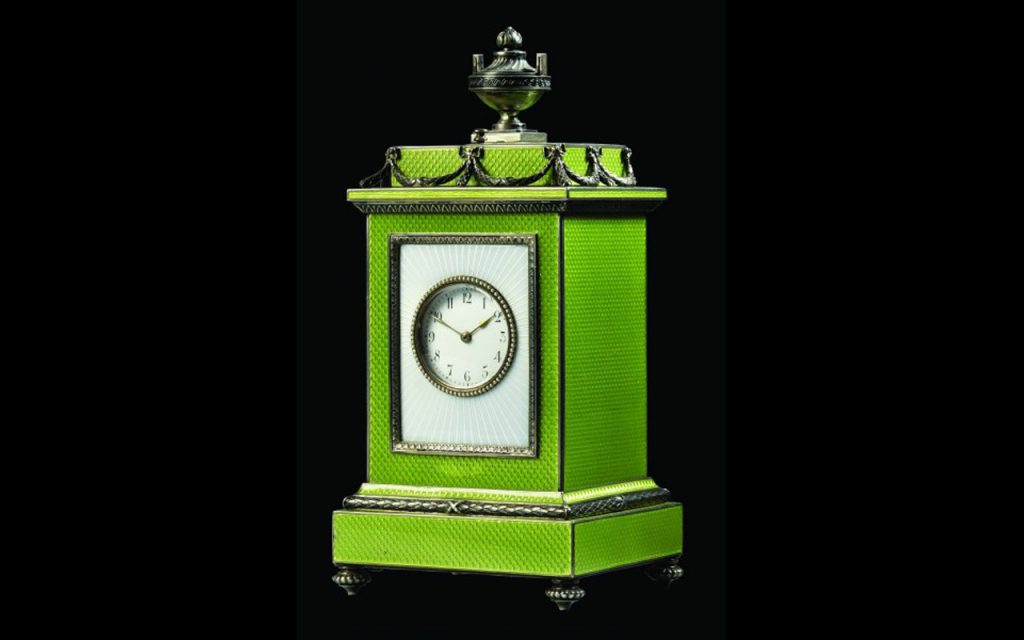
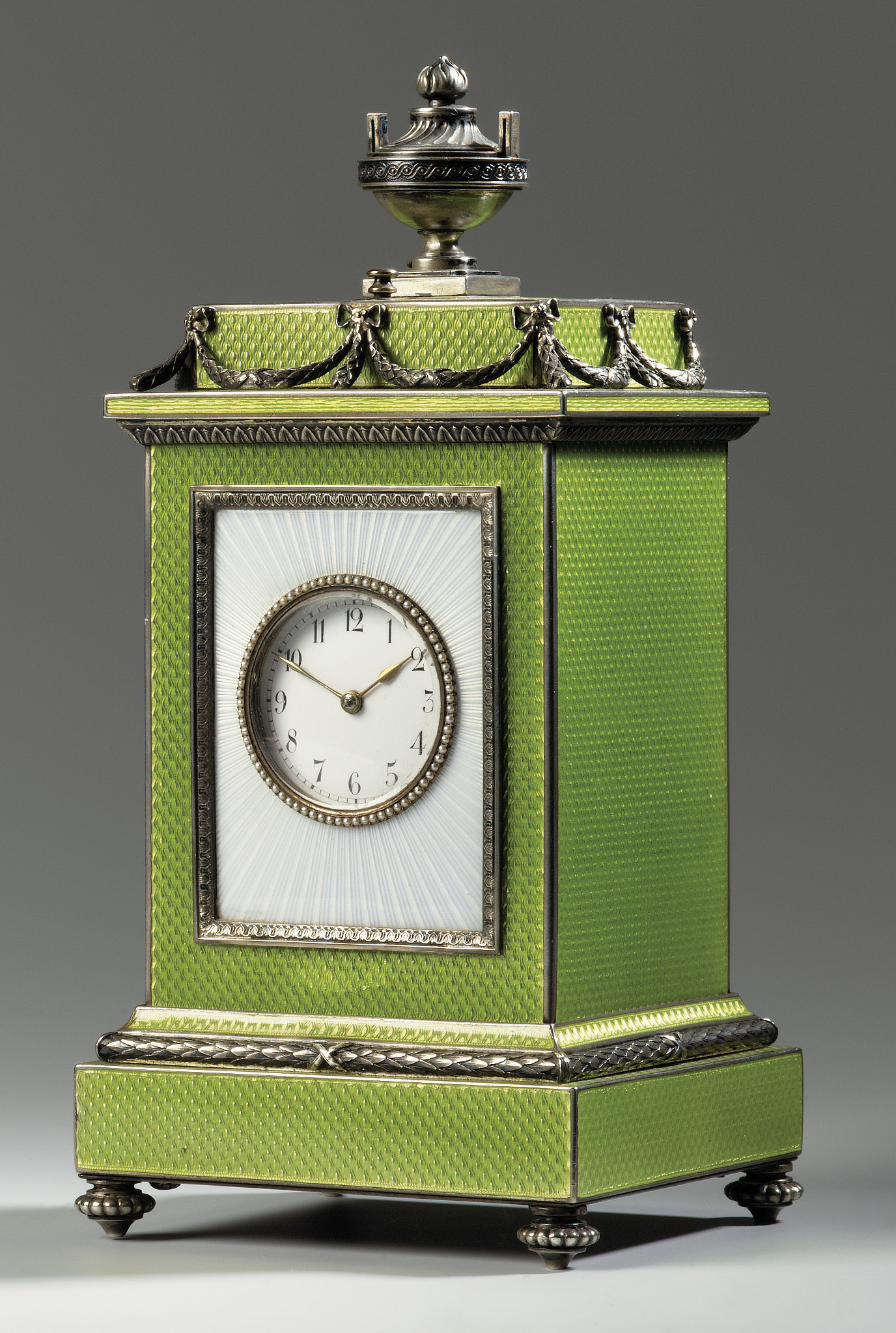
Location: Russia, Moscow
Materials: silver-gilt, opaque and painted champlevé and filigree enamel, cabochon emeralds, sapphires and amethysts, turquoise, smoky quartz and citrine 88 zolotniks
Dimensions: diameter 74.2 cm
Accession Number: RUS 113
Other Notes:
The reverse is engraved with a French translation of the Cyrillic presentation inscription that corders the central field: ‘A Monsieur Emile Loubet Président de la République Française la ville de Moscou 1902’. The silversmith also engraved his name ‘Ovtschinnicow’ for the benefit of the recipient.
The cult of St. George flourished in Russia during the reign of Yaroslav the Wise in the 11th century, and from then on St. George remained one of the most venerated saints. By the 14th century icon painters chose to depict, almost to the exclusion of any other subject from the saint’s life, his combat with a dragon – a classic image of the triumph of good over evil. As a patron saint of Russia and of the grand princes of Muscovy, St. George, with the vanquished dragon, was used in the state coat of arms and appeared on coins minted in Moscow. Thus the iconography available to Ovchinnikov when making this charger was rich with precedent and symbolism. As well as the allusion to past history, it is conceivable that Ovchinnikov was aware of Viktor Vasnetsov’s designs for the central gable over the portal of the Tretyakov Gallery in Moscow, which featured a bas-relief of the warrior saint and his adversary. An almost identical figural arrangement to that used here by Ovchinnikov was repeated by Ivan Khlebnikov on a filigree enamel Easter egg, made between 1908 and 1917, now in the Hillwood Museum, Washington DC.
Bibliography:
Haydn Williams, Enamels of the World: 1700-2000 The Khalili Collections, London 2009, cat. 254, pp. 362–3.
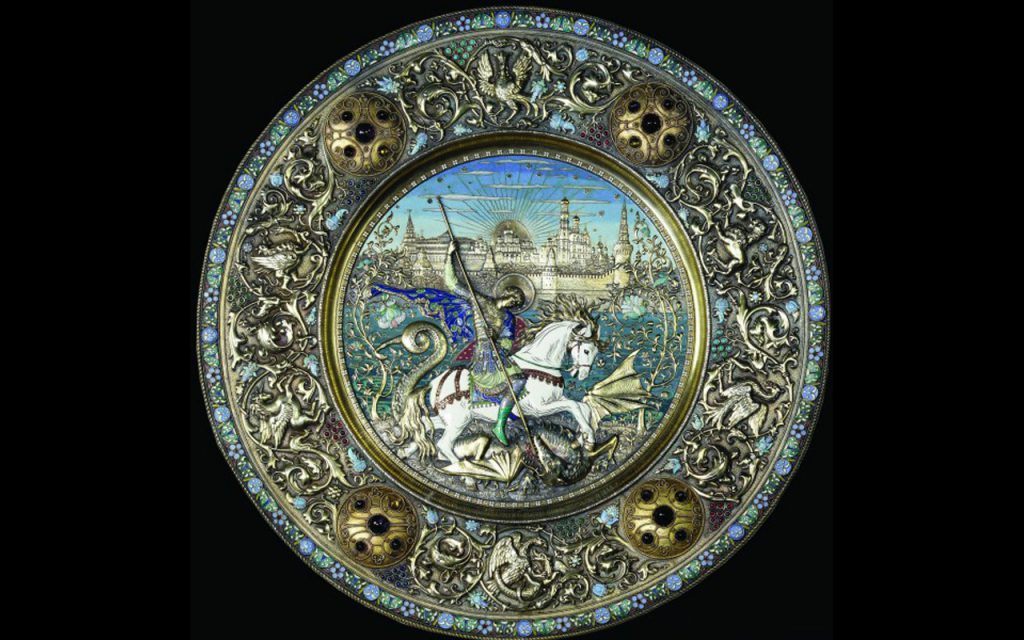
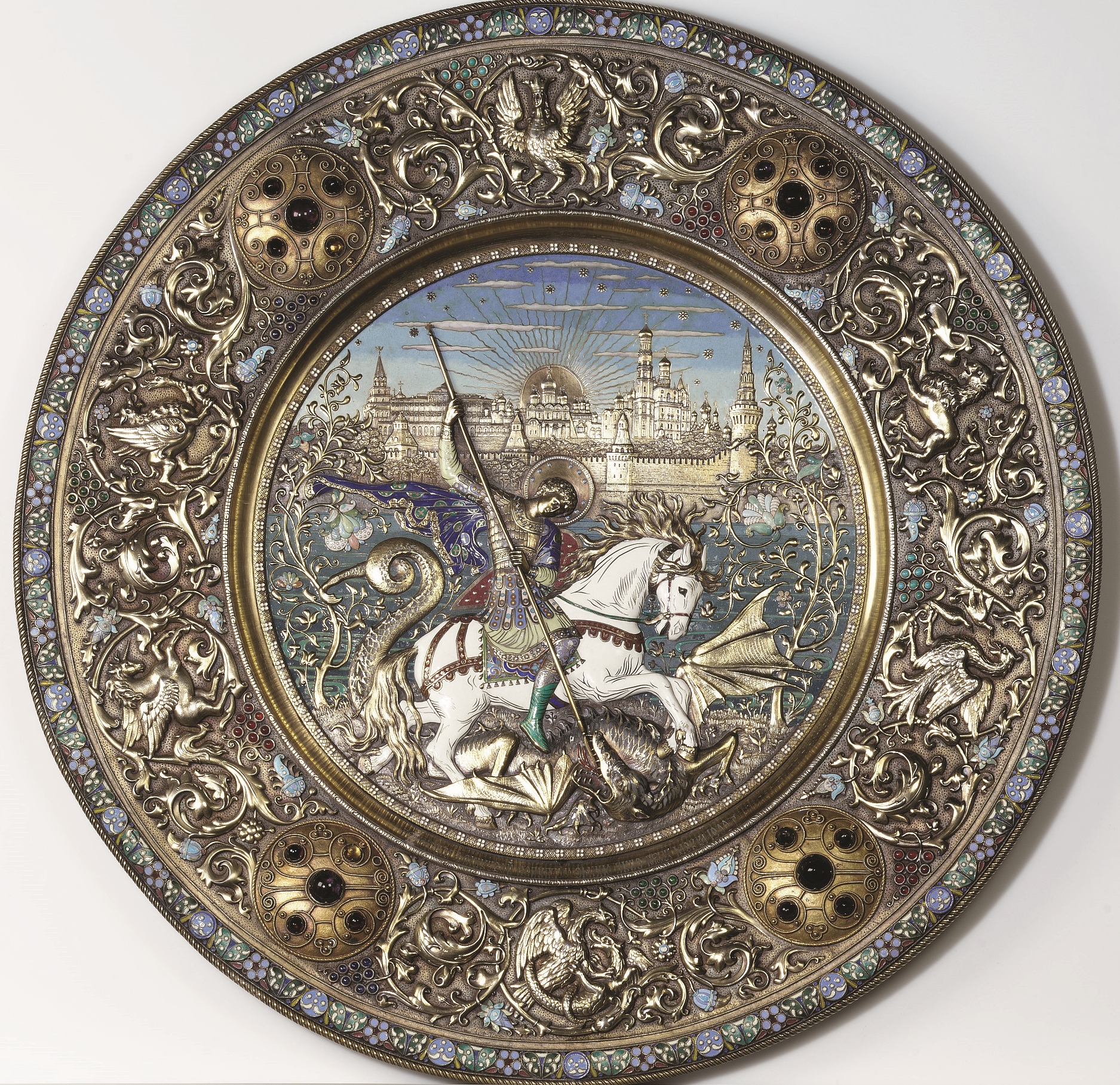
Location: Egypt, most probably Cairo
Materials: ink, gold and opaque watercolour on paper; modern facsimile binding
Dimensions: 374 folios; 57.5 x 45cm
Accession Number: QUR 317
Other Notes:
Unusually for a Mamluk Qur’an, the opening pages of each quarter (rub‘) of the text are illuminated. The most striking feature of these illuminated pages is their beautifully drawn spiral split-palmette scrolls on a ground of fine reddish-brown hachuring, which is broken to reveal the words in ‘clouds’. They are arranged as panels, with illuminated head- and footpieces and borders of elaborate gold plaiting, and marginal hasps outlined in blue. The copyist, Muhammad ibn Ibrahim ibn ‘Abd al-Rahman al-Maydumi, may have also been responsible for the illumination.
The volume was endowed upon the mosque built by Sayf al-Din Qusun al-Nasiri, an amir of Sultan al-Nasir Muhammad, near the Bab Zuwaylah in Cairo, which was completed in 729–30 AH (1329–30 AD).
Script:
main text copied in muhaqqaq script, incidentals in thulth; 11 lines to the page
Bibliography:
D. James, The Master Scribes. Qur’ans of the 10th to 14th Centuries AD, The Nasser D. Khalili Collection of Islamic Art, volume II, London 1992, cat.41, pp.162–7.
J.M. Rogers, The Arts of Islam. Masterpieces from the Khalili Collection, London 2010, cat.178, p.153.
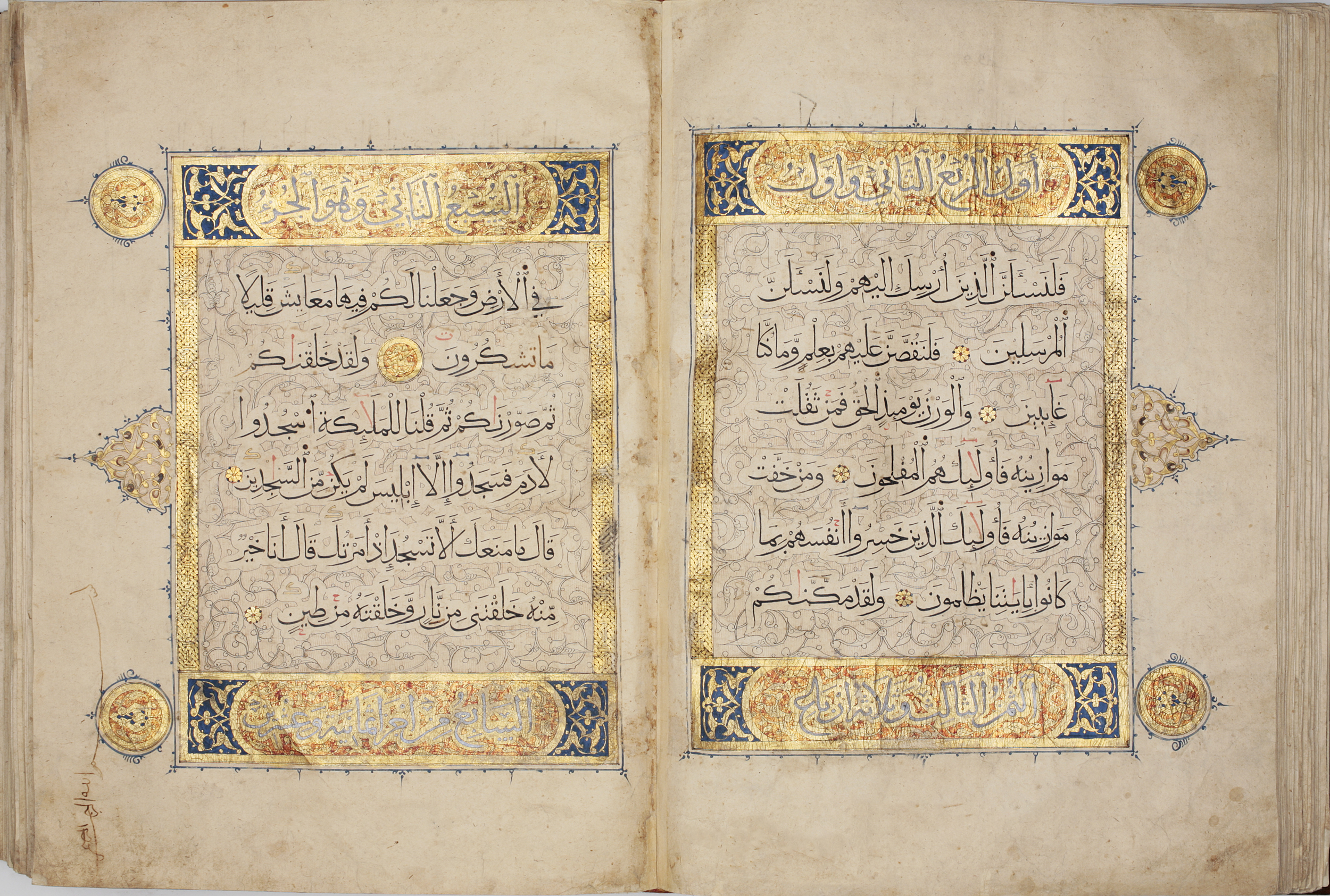
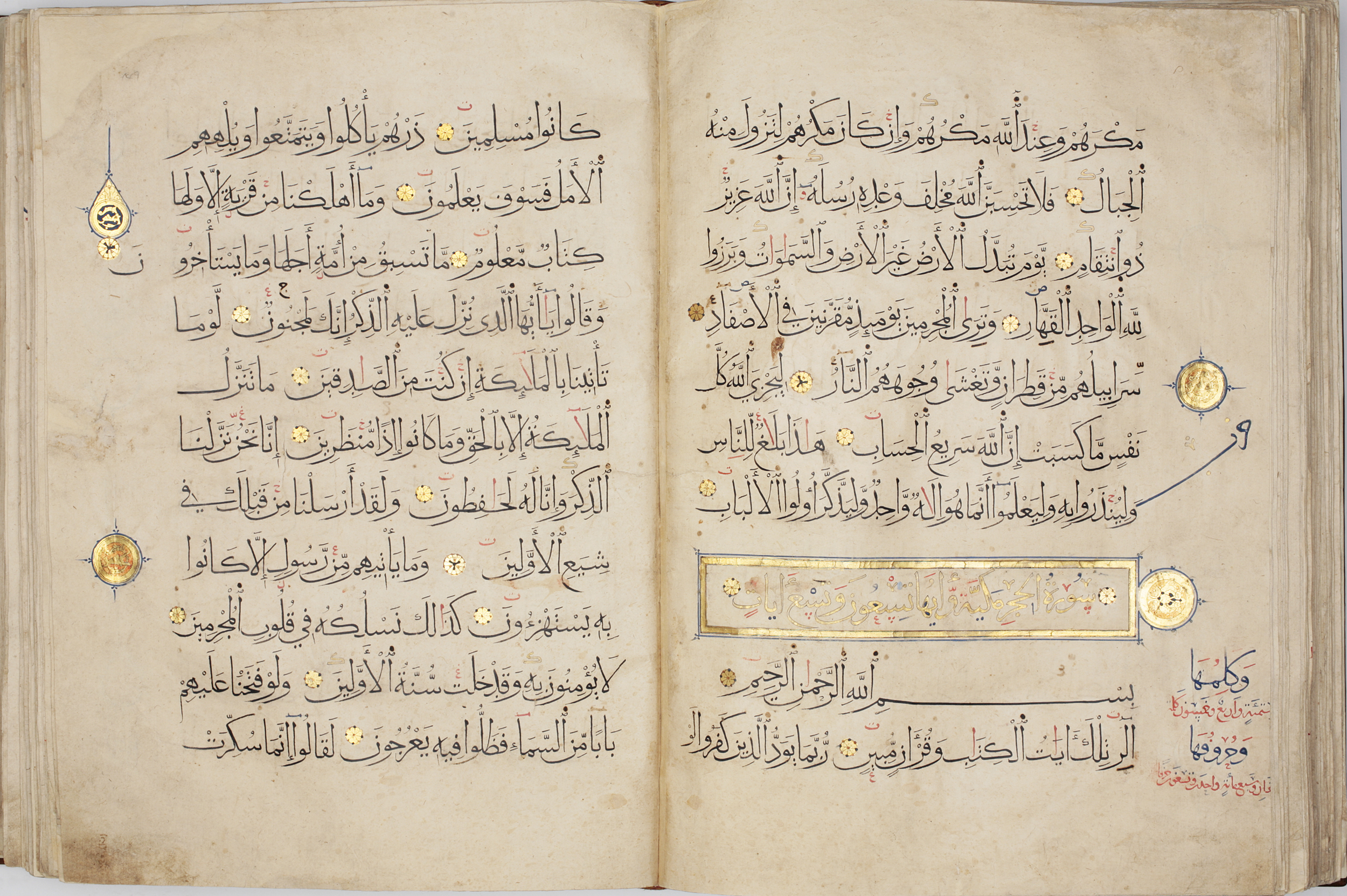
Location: struck at Makkah
Dimensions: diameter 18mm
Accession Number: AV 1074
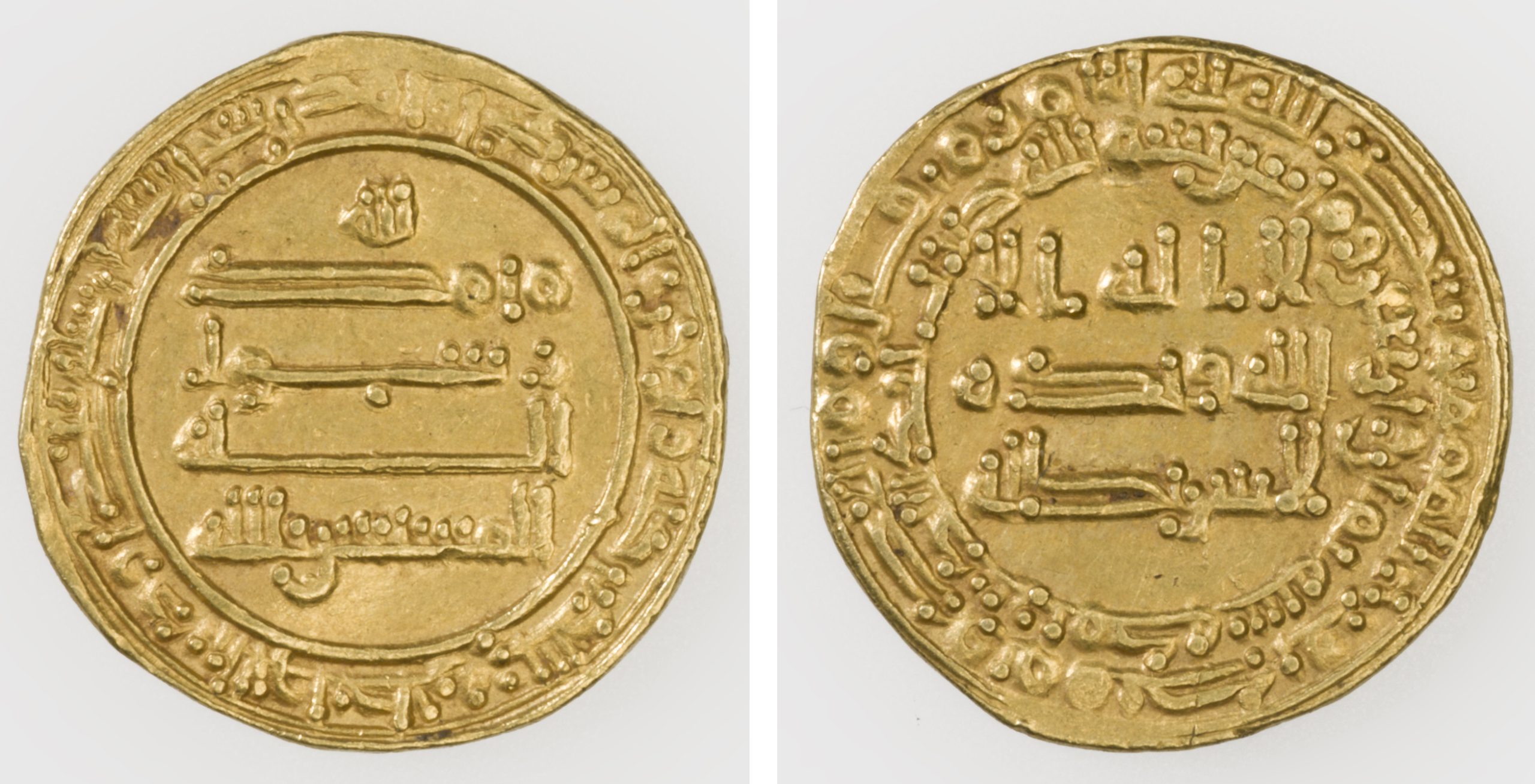
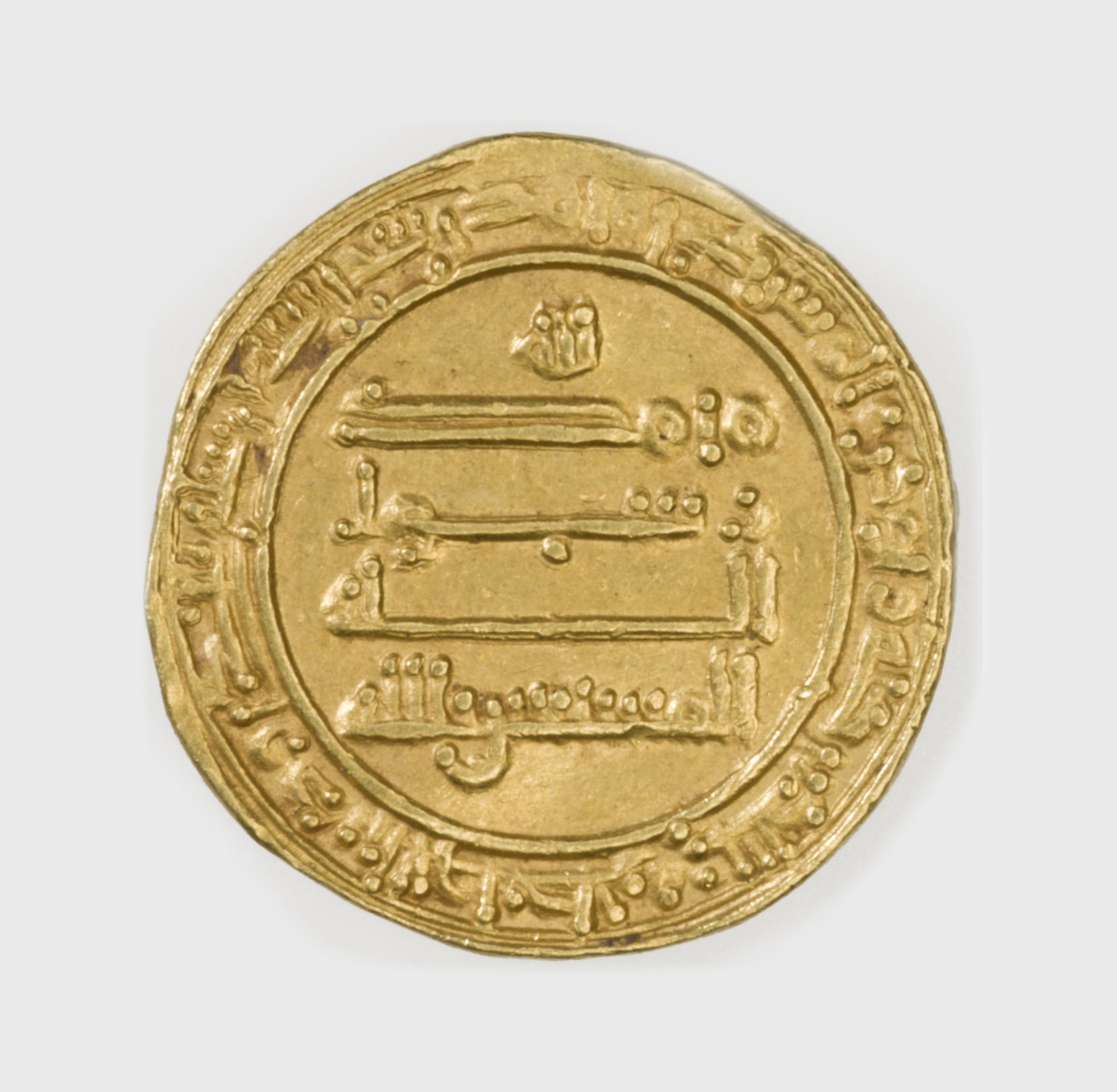
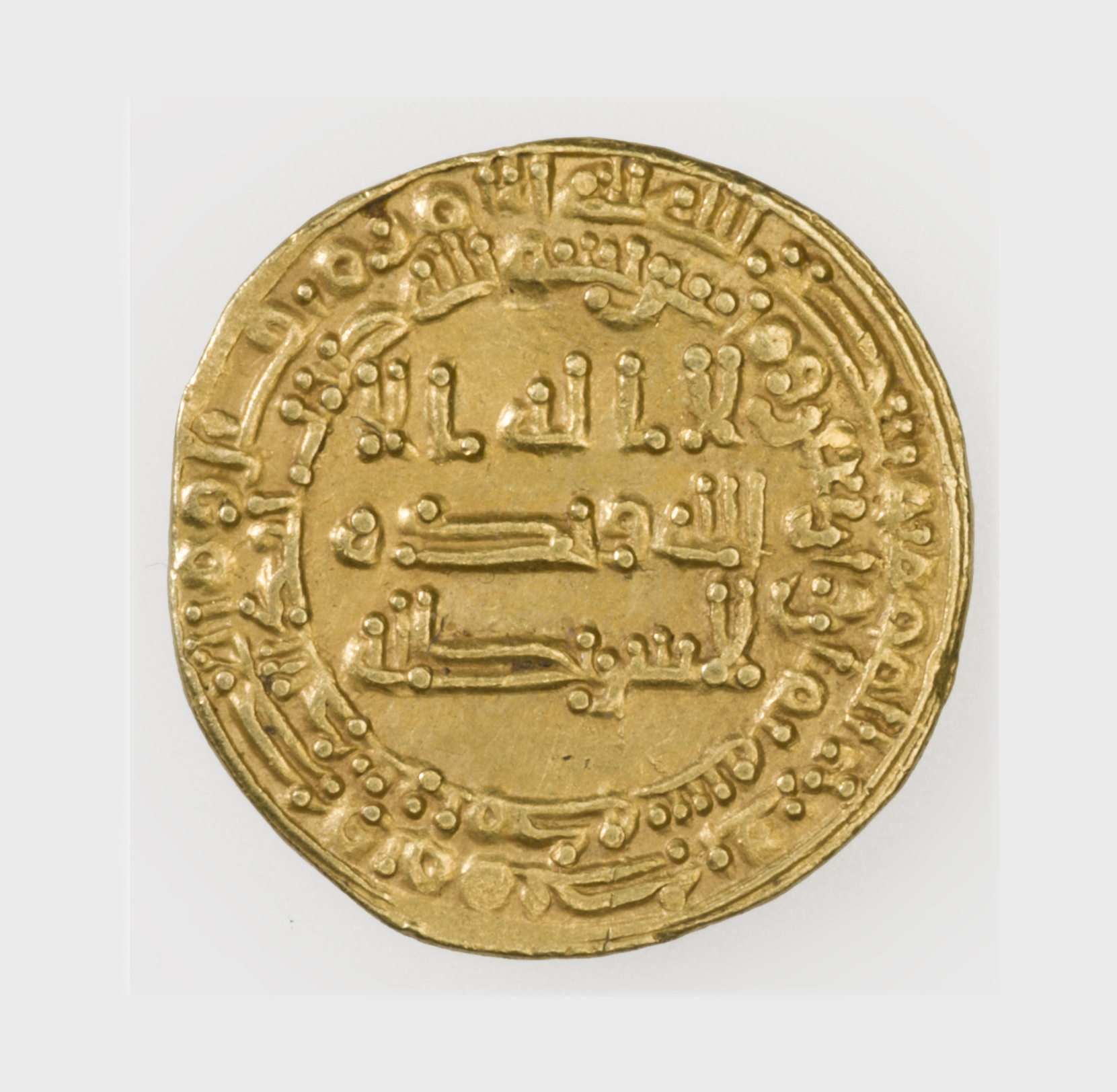
Location: struck at Makkah
Dimensions: diameter 37mm
Accession Number: AR 2629
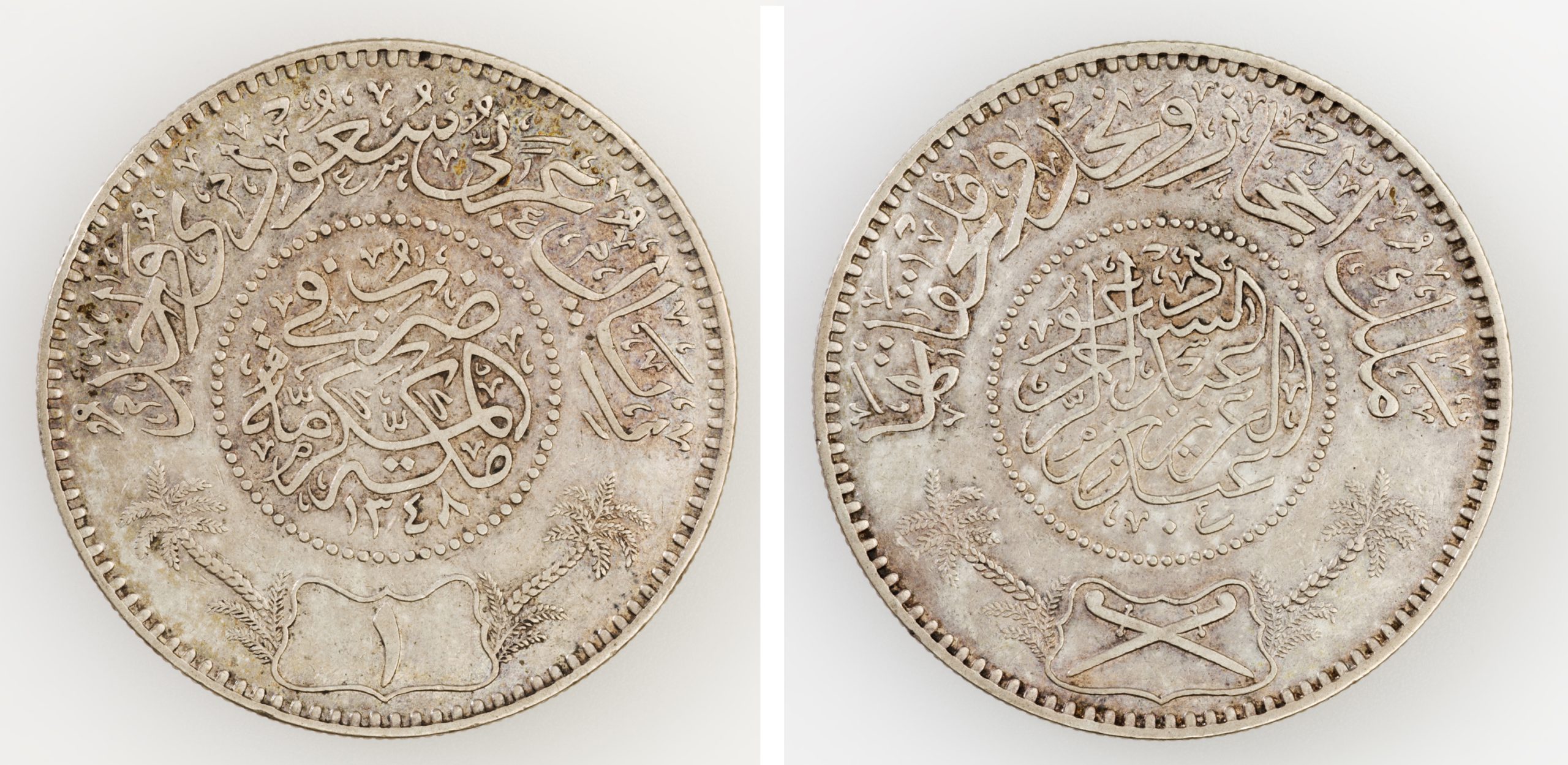
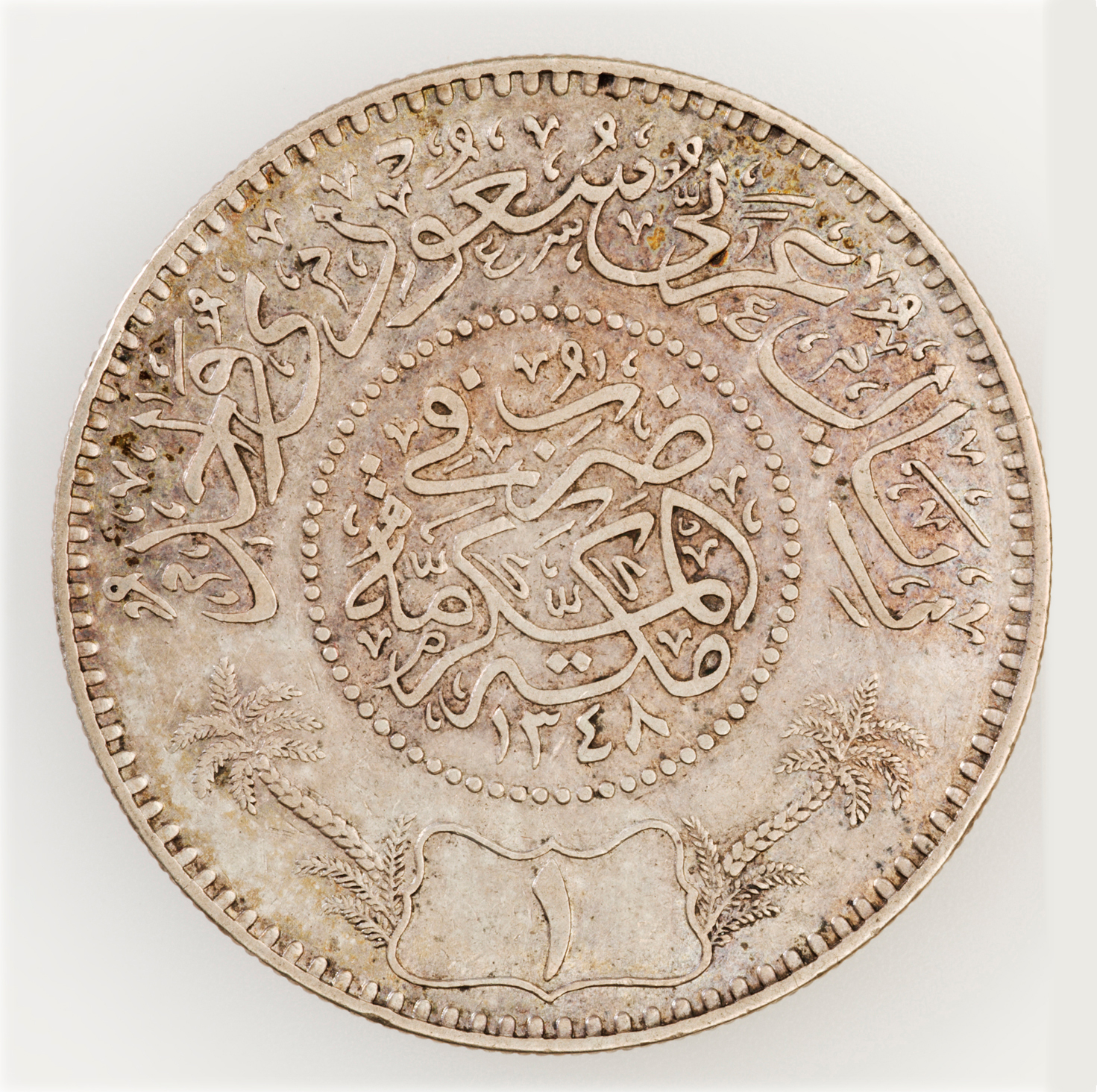
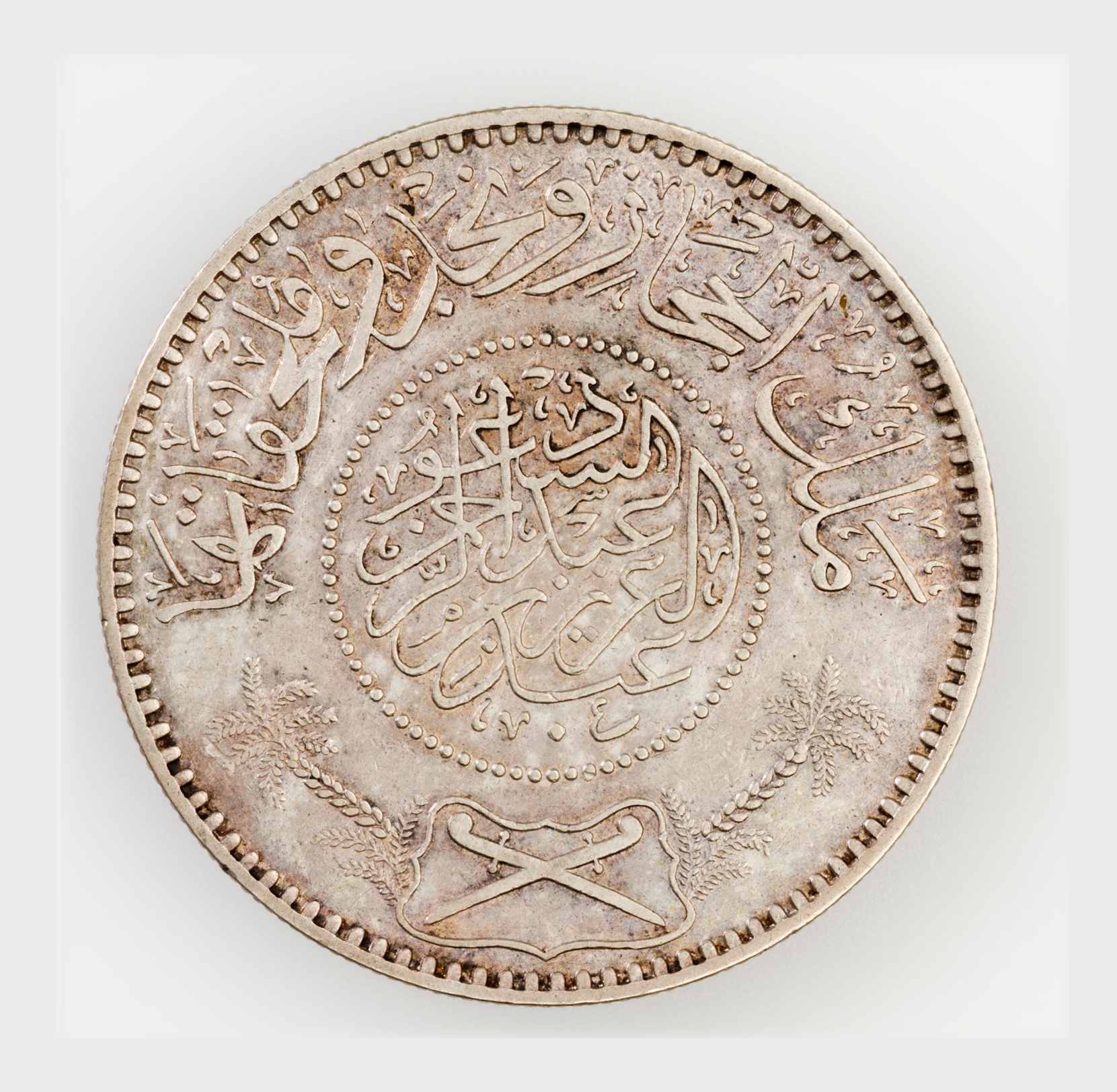
Location: struck at Makkah
Dimensions: 4.12g; diameter 24mm
Accession Number: AV 138
Other Notes:
An extremely rare issue.
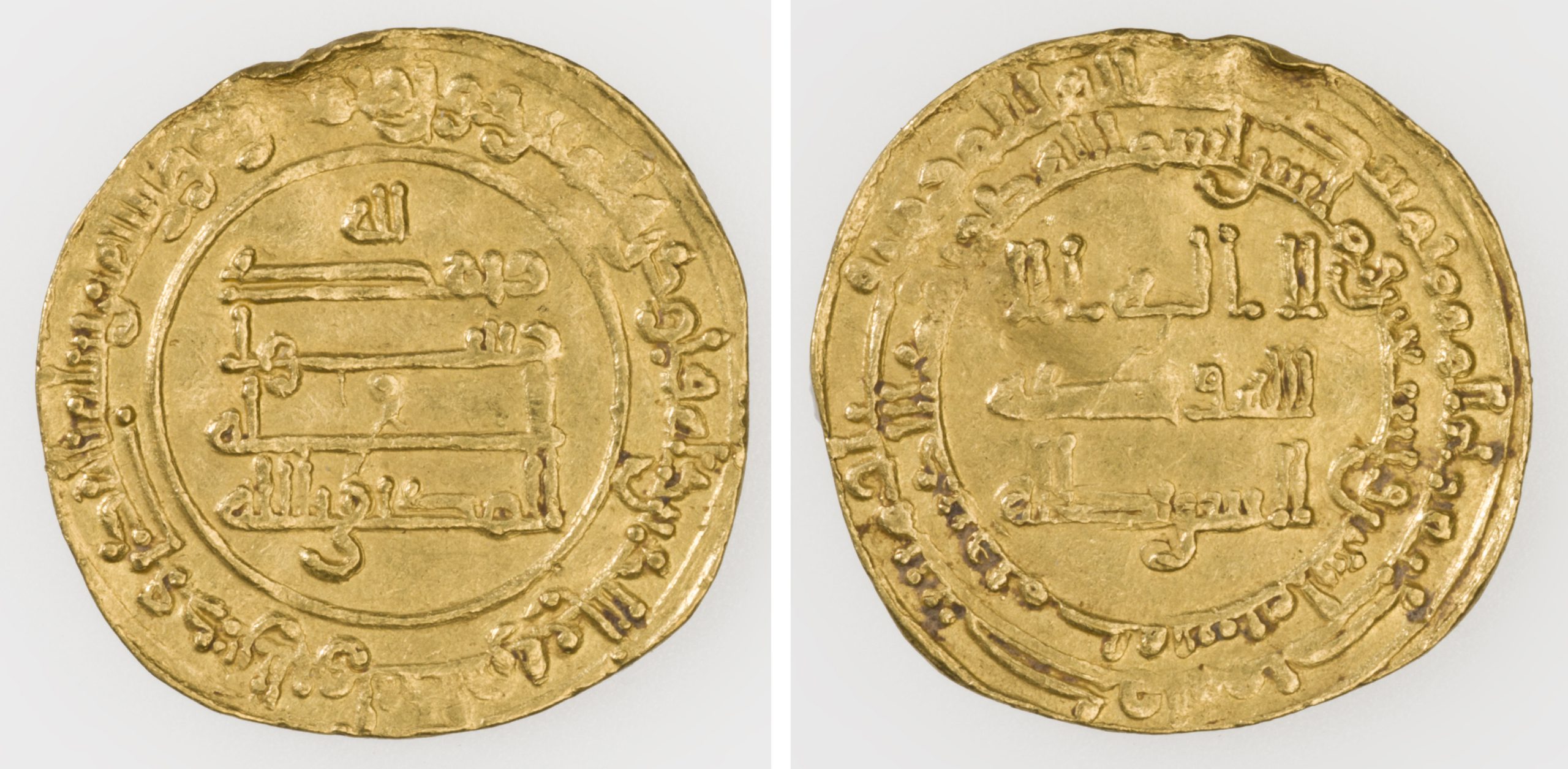
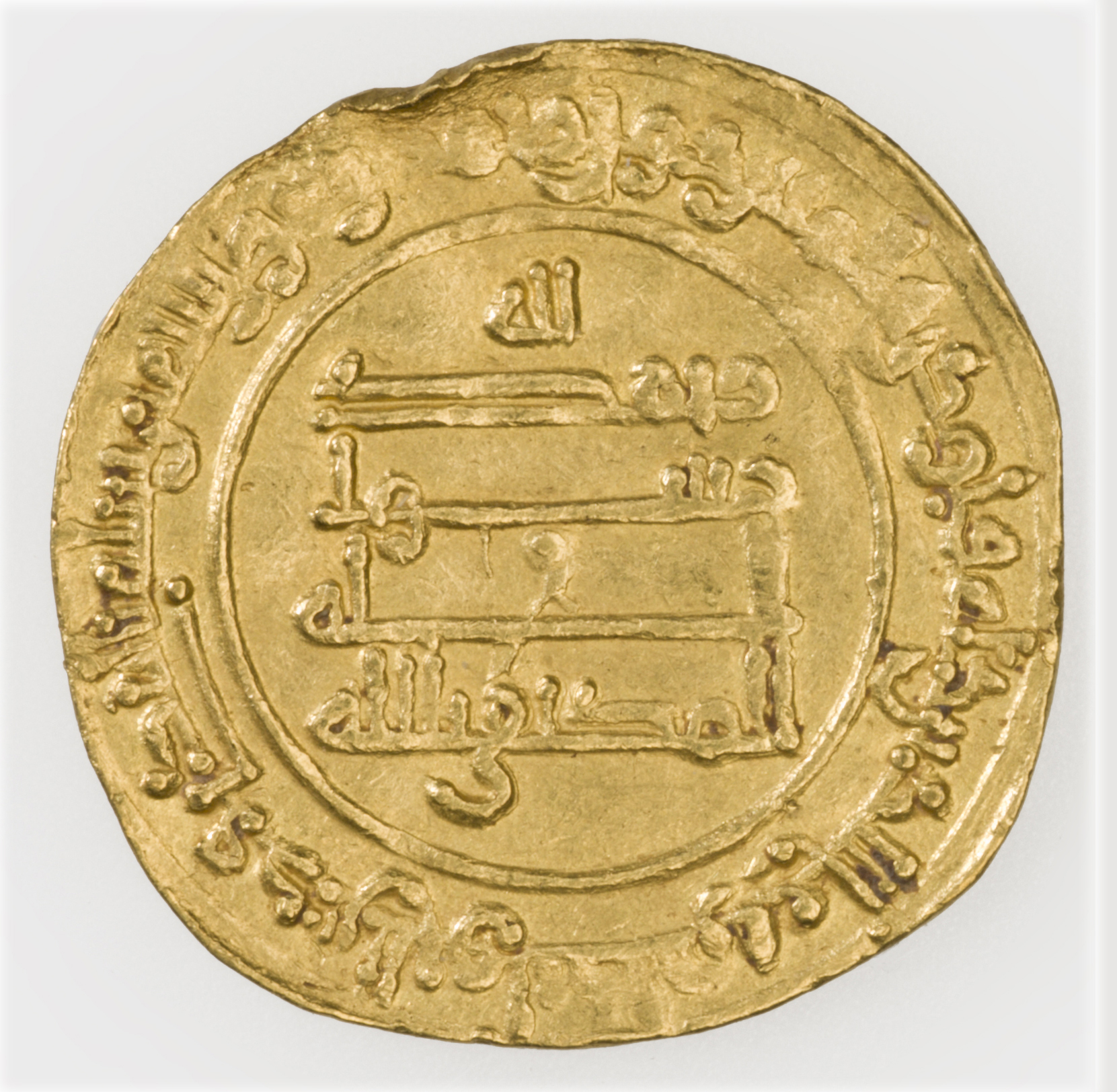
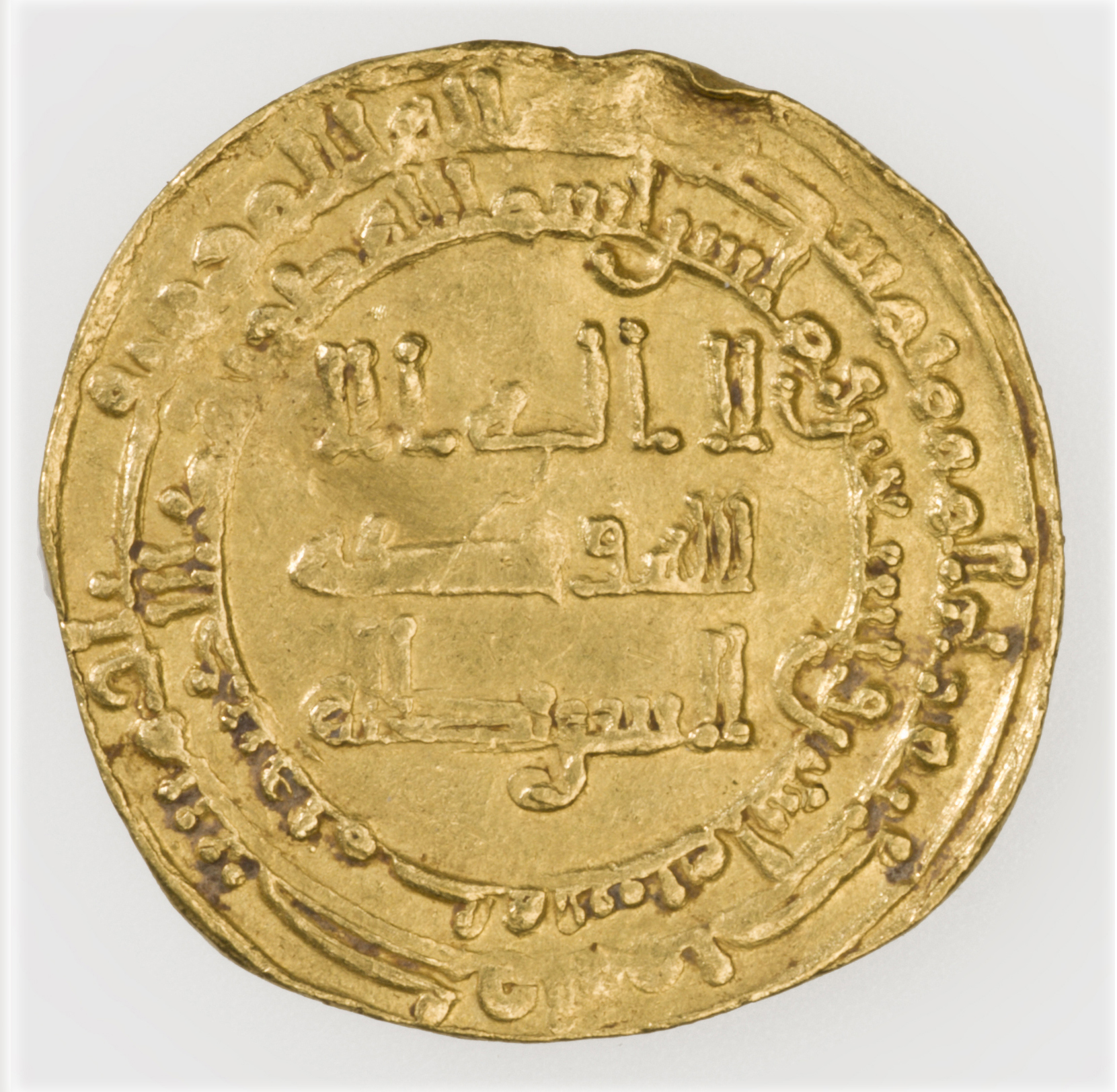
Location: Japan
Materials: earthenware, painted and gilded
Dimensions: height 29.2 cm
Accession Number: S 149
Other Notes:
An earthenware jar and cover with an ovoid body painted and gilt with an extensive rural landscape depicting numerous farmers involved in the harvesting and preparation of rice, others walking in a garden before a tea-house. A small panel painted with silk merchants on a path beside a stream, displaying their wares before a group of young women, Mount Fuji rising through clouds in the distance. The borders enamelled and gilt with stylized mill-wheels, flowers, and scrolls. The cover decorated with formal floral motifs.
This is an example of a piece in Satsuma style by one of several workshops in Kyoto that specialized in this type of ware. The crest of the Shimazu family (see also S 162), lords of the Satsuma domain in the south of Japan, many hundreds of miles from Kyoto, is added to the signature to stress the supposed ancestry of the ware, which many Western buyers continued to believe was actually made in Satsuma. The faces of the young women gazing out at Mount Fuji are loosely based on the woodblock prints of Kitagawa Utamaro (1754-1806), which were extremely popular in the West at this period.
Bibliography:
O. Impey, M. Fairley (eds.), Meiji No Takara: Treasures Of Imperial Japan: Ceramics Vol II, London 1995, cat. 136.
J. Earle, Splendors of Imperial Japan: Arts of the Meiji period from the Khalili Collection, London 2002, cat. 91, p. 148.
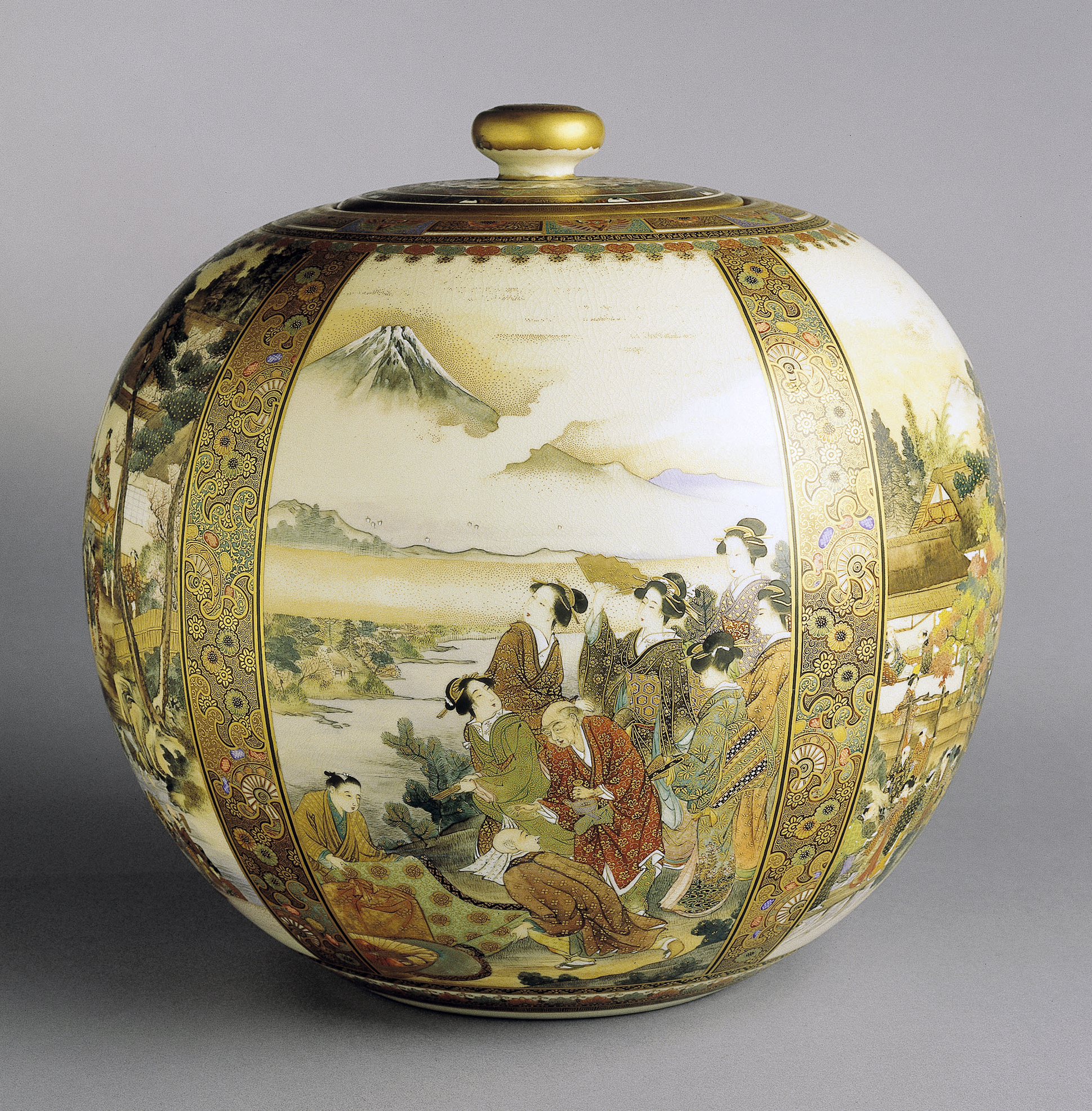
Location: Japan
Materials: earthenware, painted and gilded
Dimensions: diameter 14.8 cm
Accession Number: S 128
Other Notes:
An earthenware bowl, with a fluted kiku-form body painted and gilt on both interior and exterior with an autumnal maple-tree. The leaves on the branches turning from green to orange.
At the end of the Meiji Era, Yabu Meizan’s workshop began to make a number of vases and bowls that were decorated with a single motif, carefully placed so as to complement the overall shape of the piece, instead of treating the pottery merely as a vehicle for virtuoso miniaturist painting. This return to a more traditional approach to ceramic decoration received official praise, but as it was not commercially successful the workshop continued to produce work in the conventional Meizan style.
Bibliography:
O. Impey, M. Fairley (eds.), Meiji No Takara: Treasures Of Imperial Japan: Ceramics Vol II, London 1995, cat. 97.
J. Earle, Splendors of Imperial Japan: Arts of the Meiji period from the Khalili Collection, London 2002, cat. 95, p. 152.
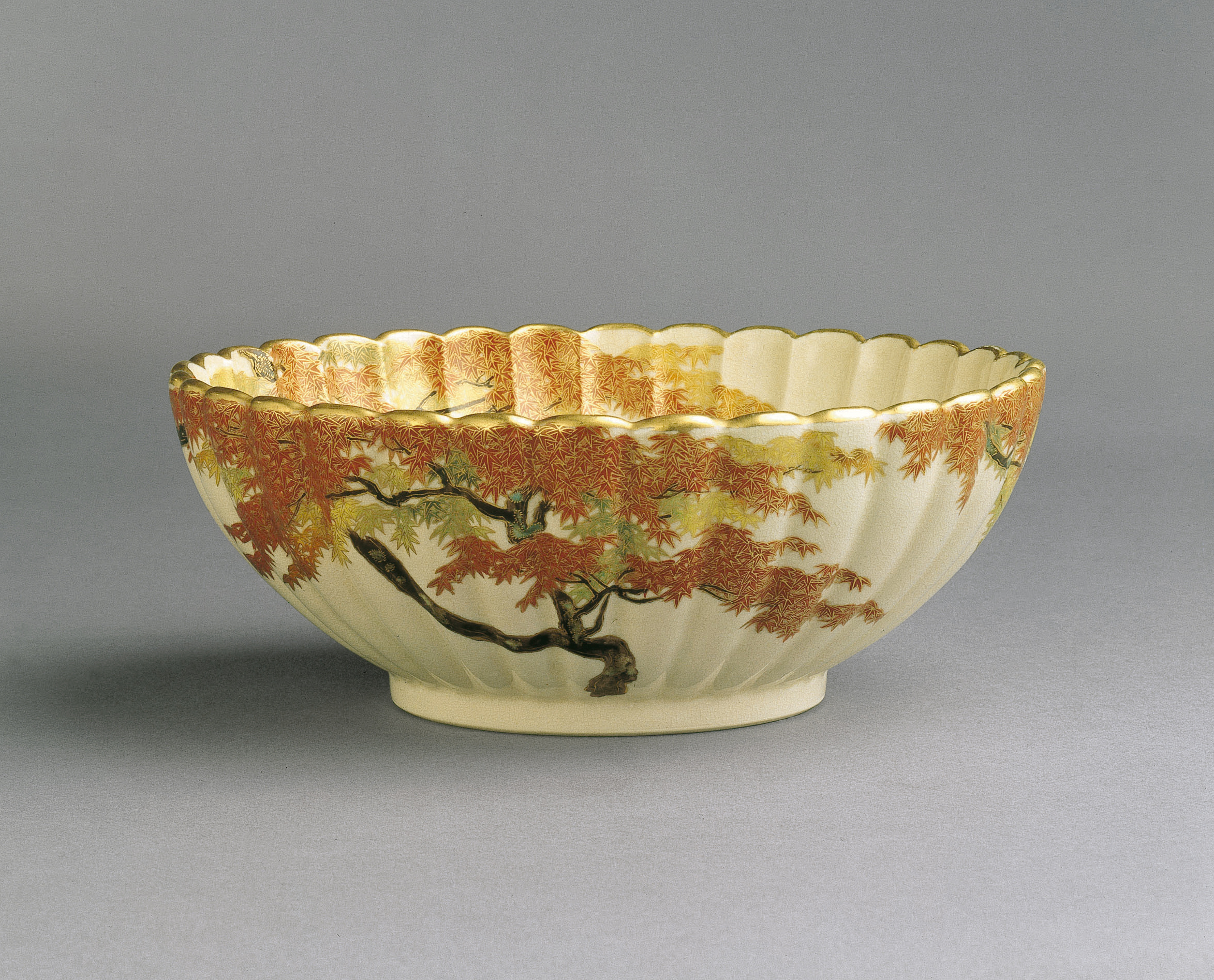
Location: mint: Dimashq (Damascus, Syria)
Dimensions: 2.79g; 27mm
Accession Number: AR 6320
Other Notes:
Obverse field: la ilaha illa Allah wahdahu la sharika lahu; margin: bism Allah, followed by denomination, mint and date.
Reverse field: surah al-Ikhlas (CXII); margin: Muhammad rasul Allah, followed by surah al-Tawbah (IX), verse 33.
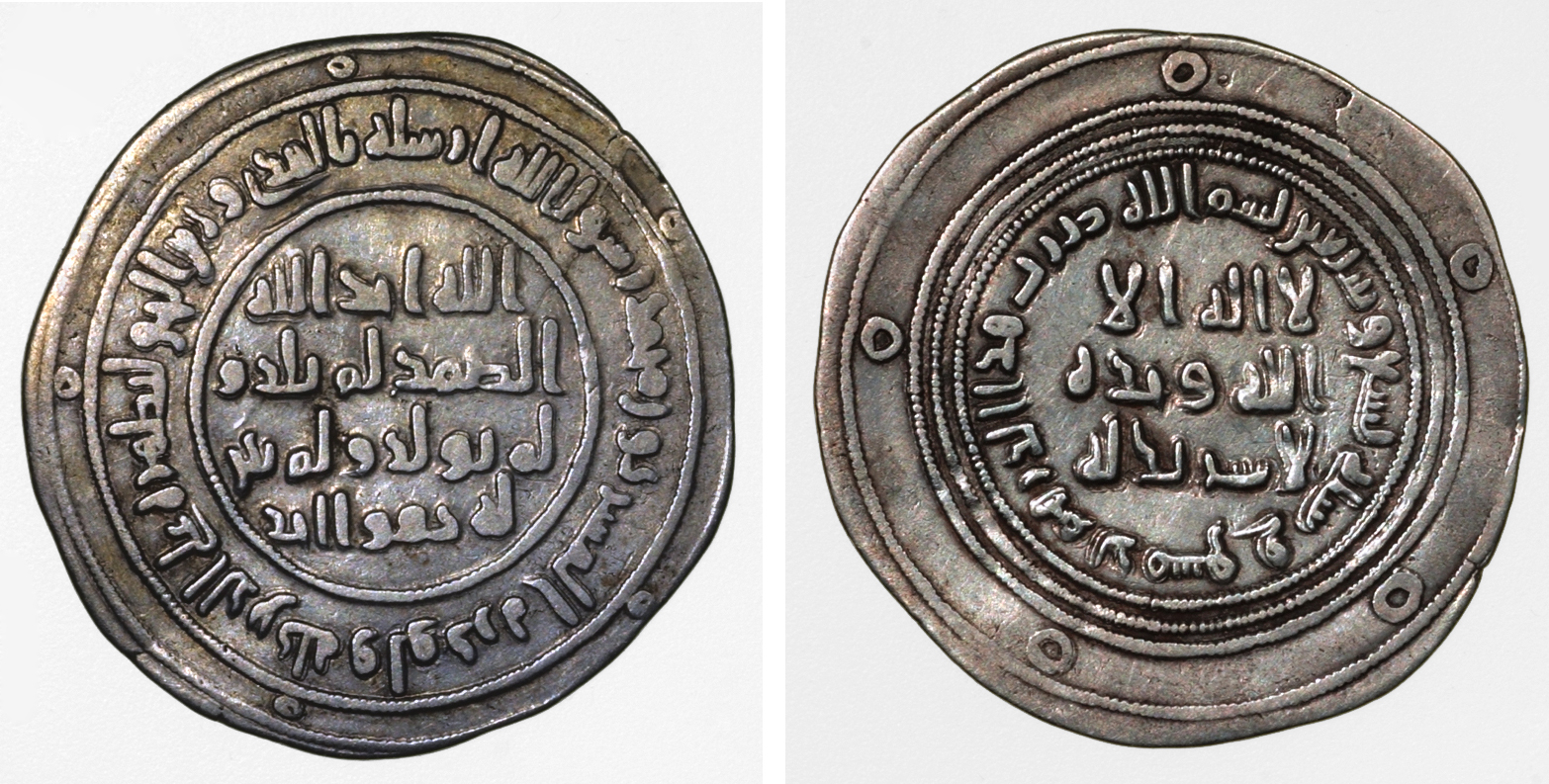
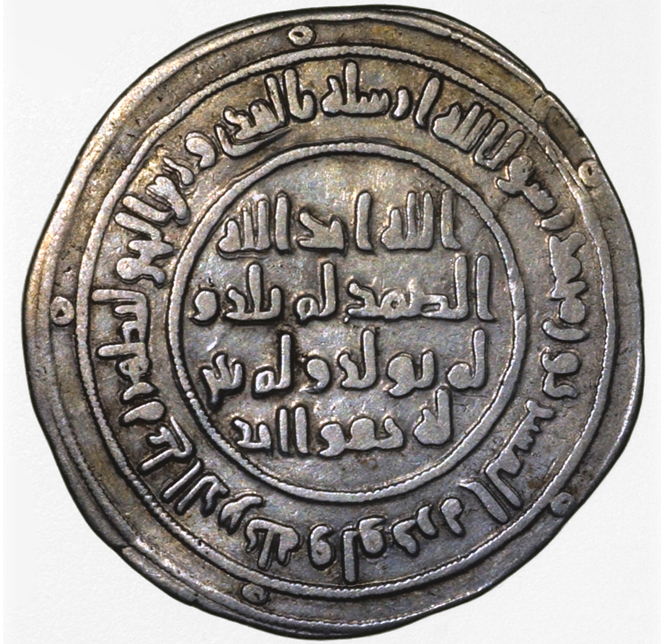
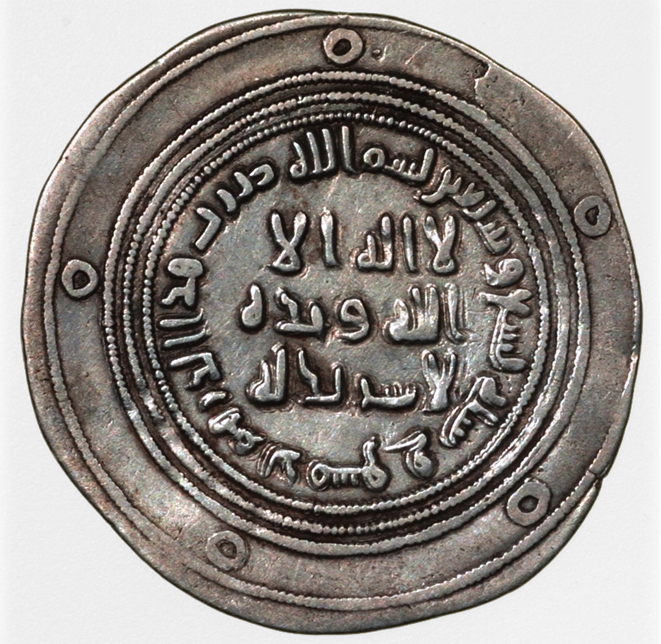
Location: mint: al-Basrah (Basra, Iraq)
Dimensions: 2.78g; 27mm
Accession Number: AR 6279
Other Notes:
Obverse field: la ilaha illa Allah wahdahu la sharika lahu; margin: bism Allah, followed by denomination, mint and date.
Reverse field: surah al-Ikhlas (CXII); margin: Muhammad rasul Allah, followed by surah al-Tawbah (IX), verse 33.
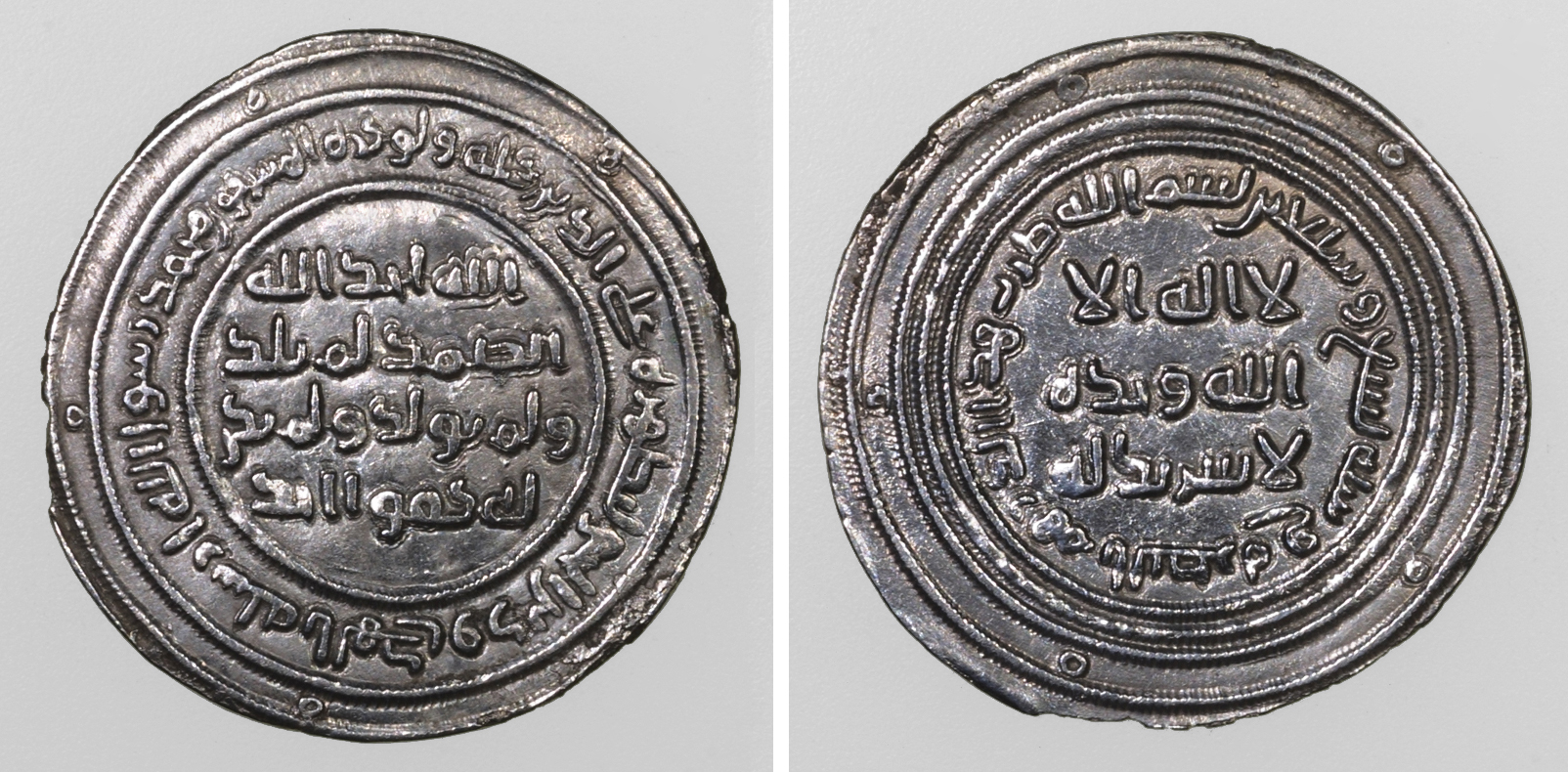
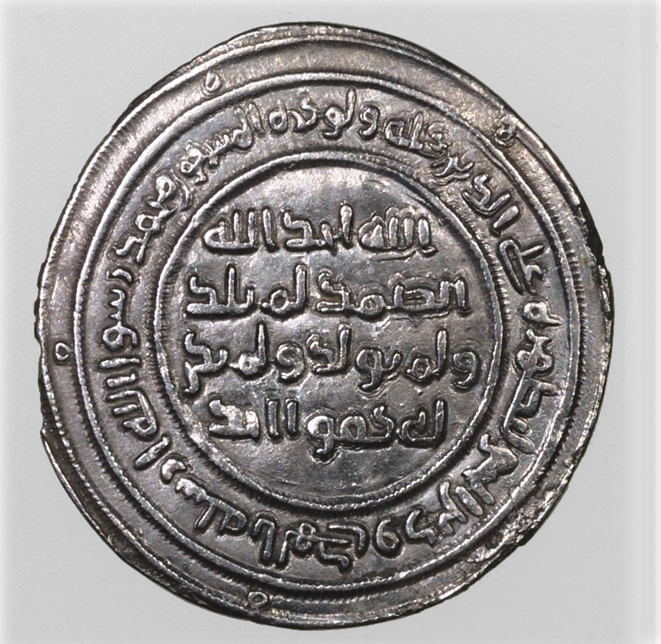
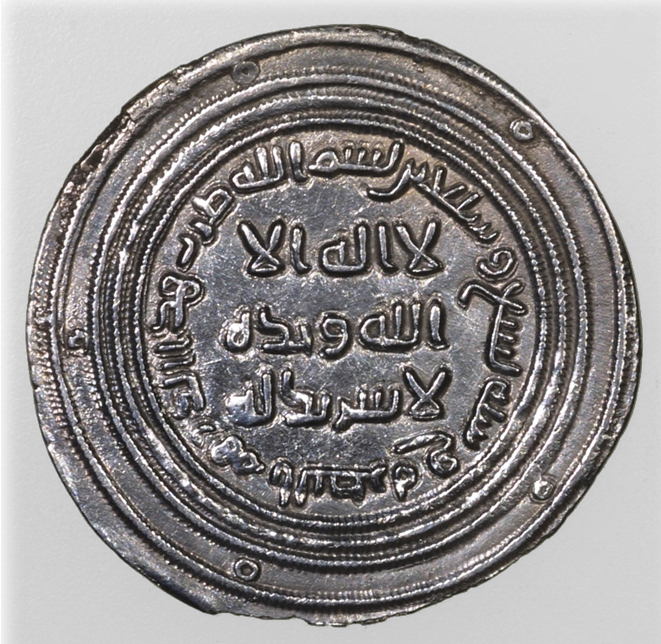
Location: without mint name; but almost certainly struck in Damascus
Dimensions: 4.24g; 19mm
Accession Number: AV 1071
Other Notes:
This is the first truly Islamic gold coin, bearing Arabic inscriptions only.
Obverse field: la ilaha illa Allah wadahu la sharika lahu; margin: Muhammad rasul Allah, followed by surah al-Tawbah (IX), verse 33, in part.
Reverse field: surah al-Ikhlas (CXII), verses 1–3; margin: bism Allah, followed by denomination and date.
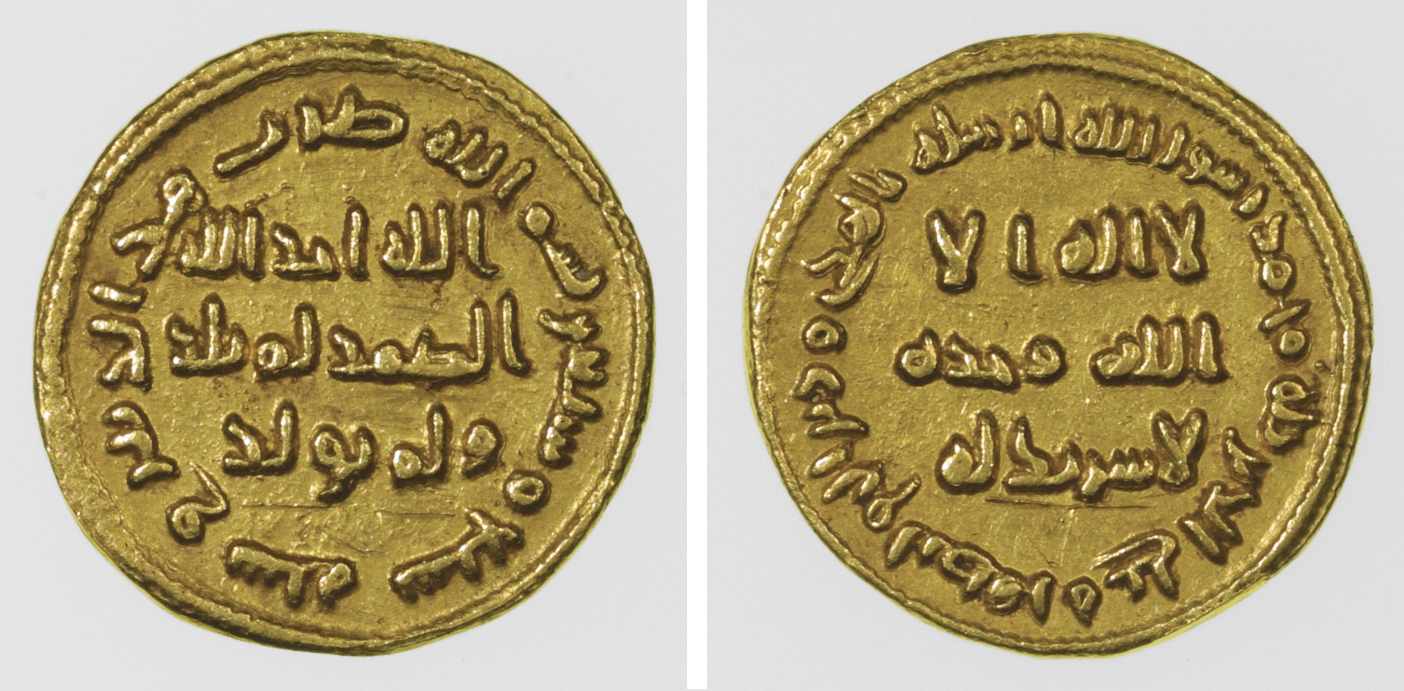
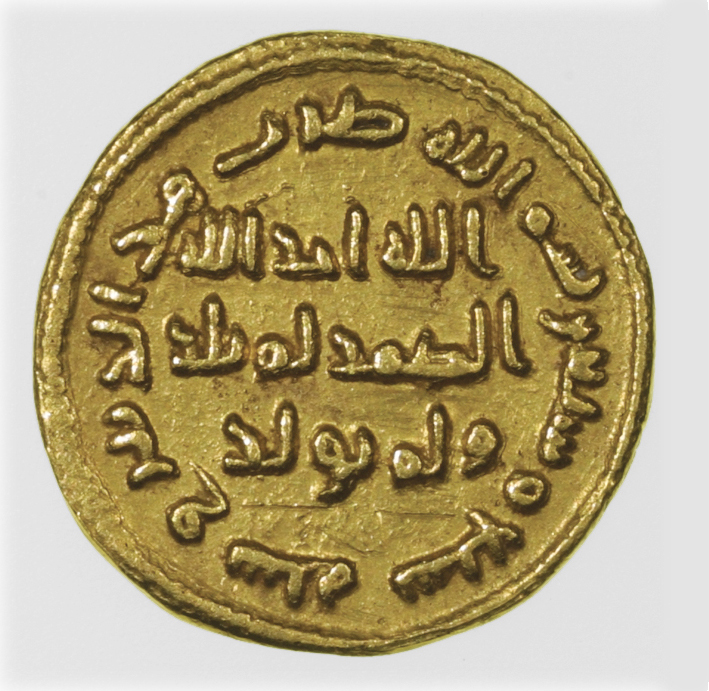
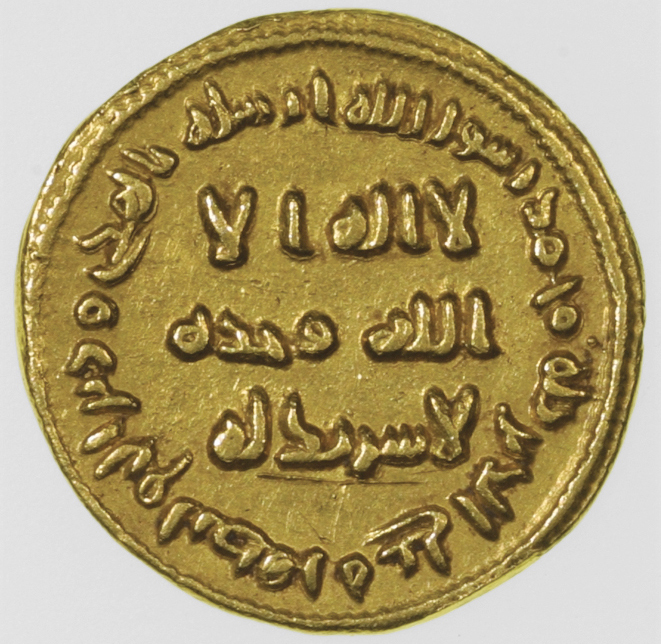
Location: mint: Basra
Dimensions: 3.87g; 32mm
Accession Number: AR 7
Other Notes:
Obverse: Sasanian bust facing right; to right downwards, a legend in Pehlevi, awbytala y-zyyatan (‘Ubayd Allah bin Ziyad); to left downwards: afzut/ gdh (‘may kingship increase’); marginal inscription beginning at 4:00, clockwise: bism Allah followed by three points.
Reverse: fire altar flanked by two attendants with the date hftpnja downwards to left and the mint name bjra downwards to right.
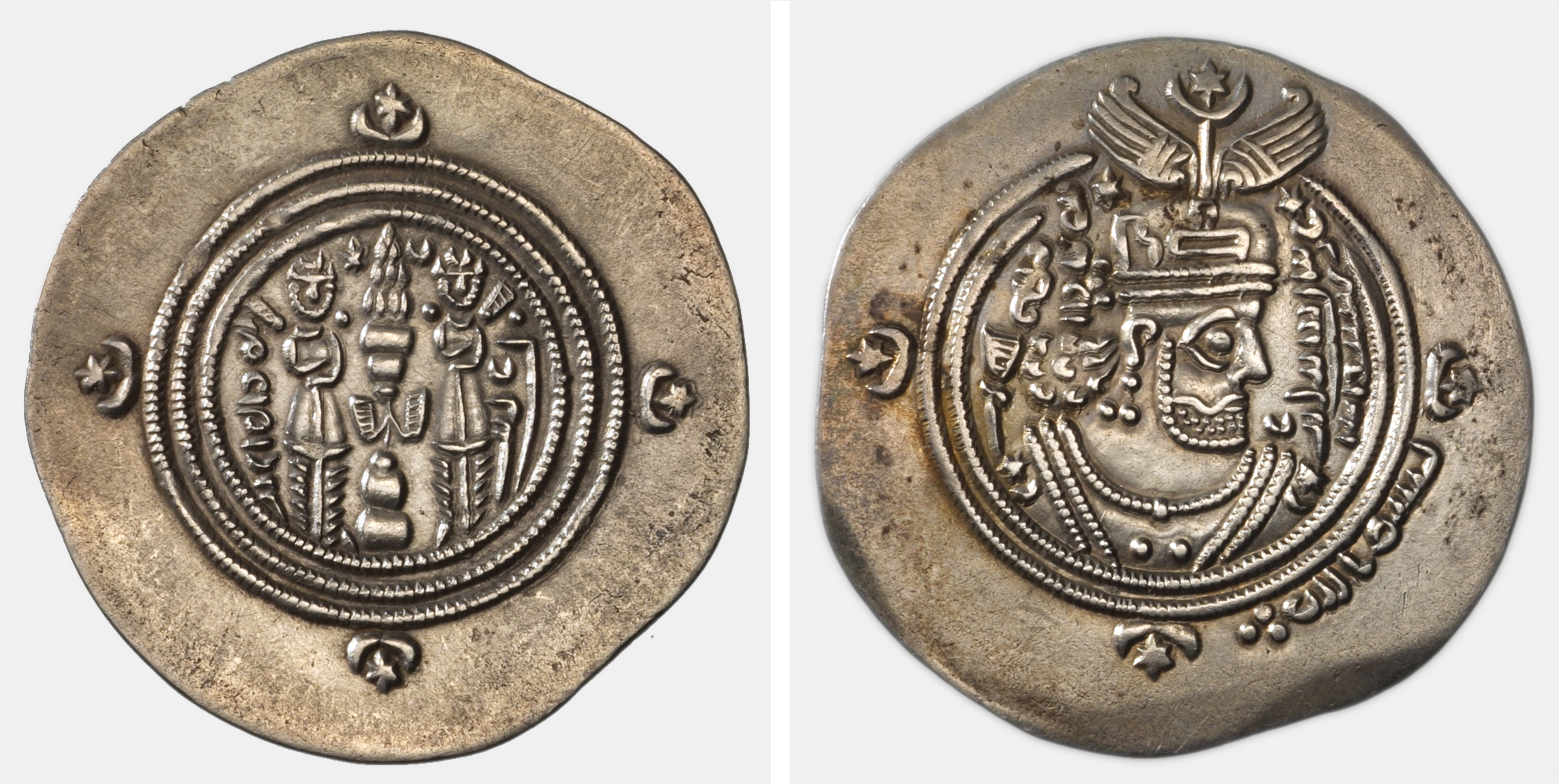
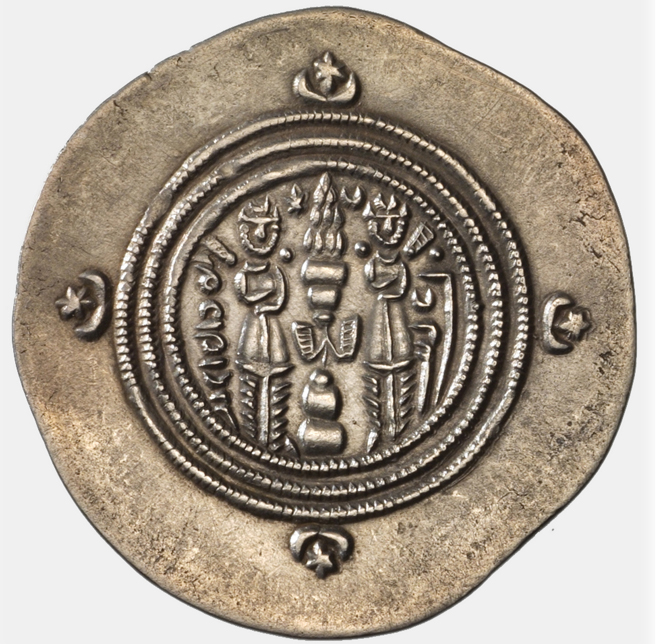
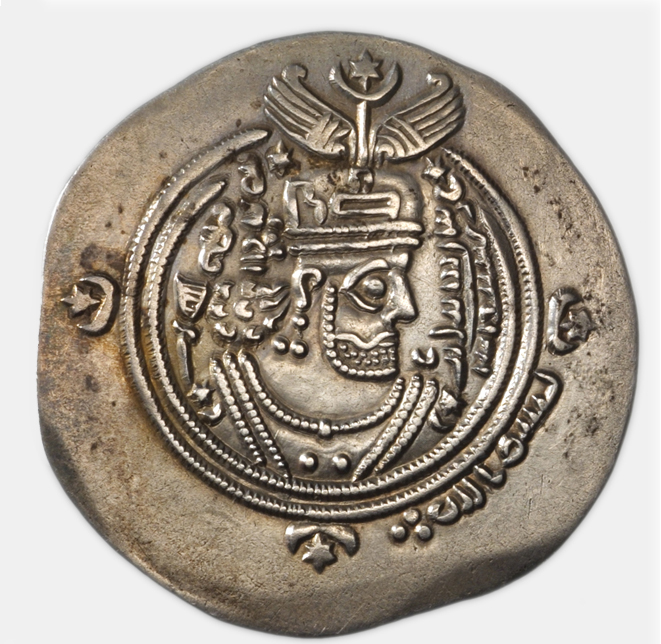
Location: without mint name; but almost certainly struck in Damascus
Dimensions: 4.38g; 20mm
Accession Number: AV 1085
Other Notes:
This is the first gold coin to bear a Muslim inscription (the kalimah).
Obverse: three figures, central figure bearded and larger, all wearing long robes and crowns without a cross, and all holding staffs sumounted by a pellet in their right hand.
Reverse: transformed cross on four steps, ‘B’ to left, ‘I’ to right; marginal inscription in Arabic beginning 12:00, bism Allah la ilaha illa Allah wahdahu Muammad rasul Allah.
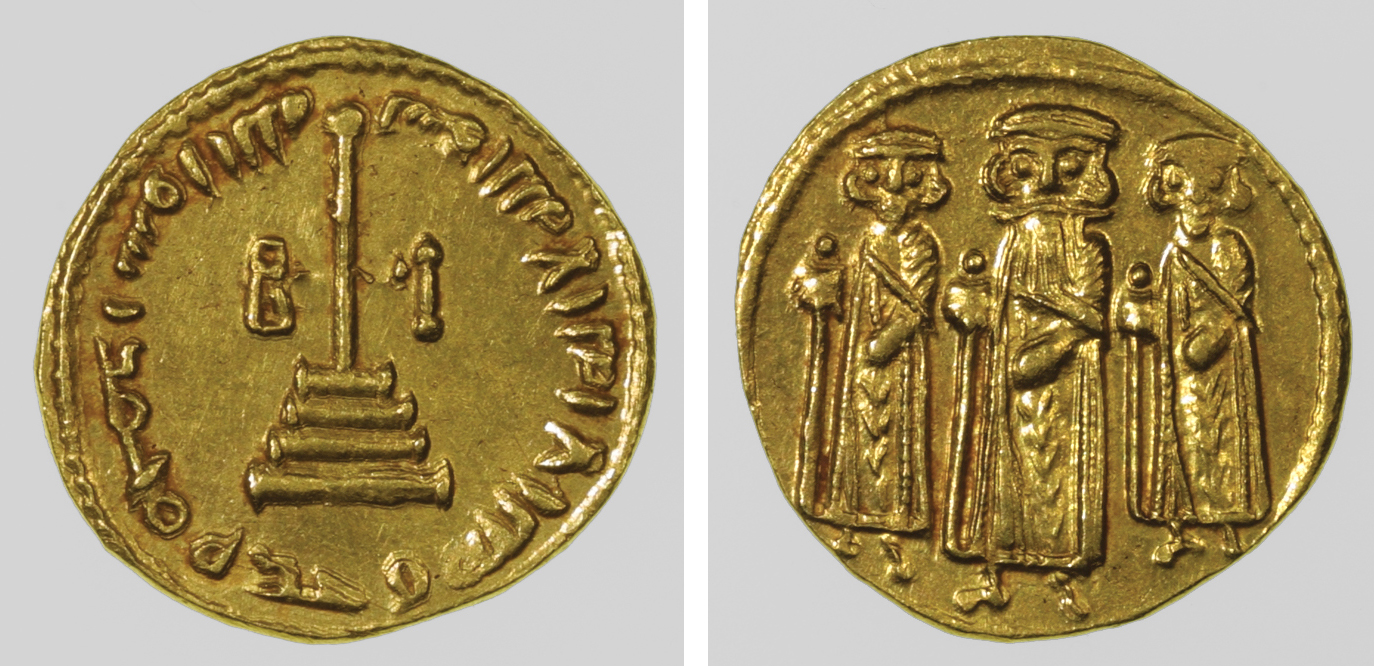
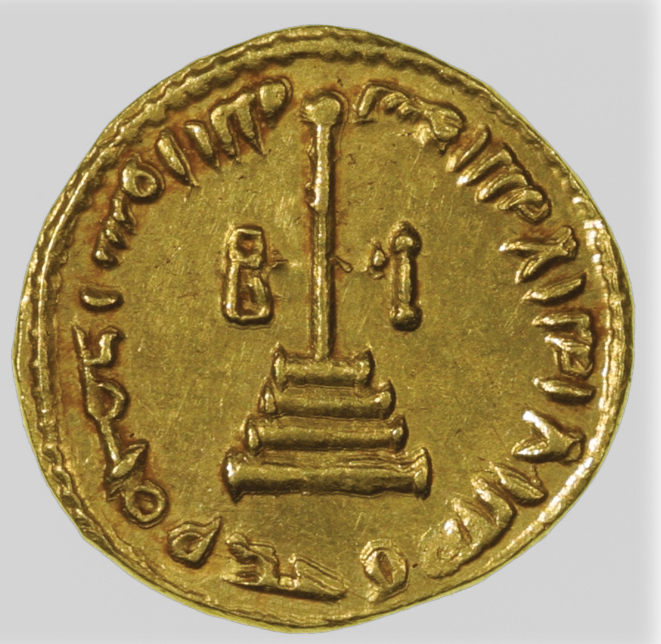
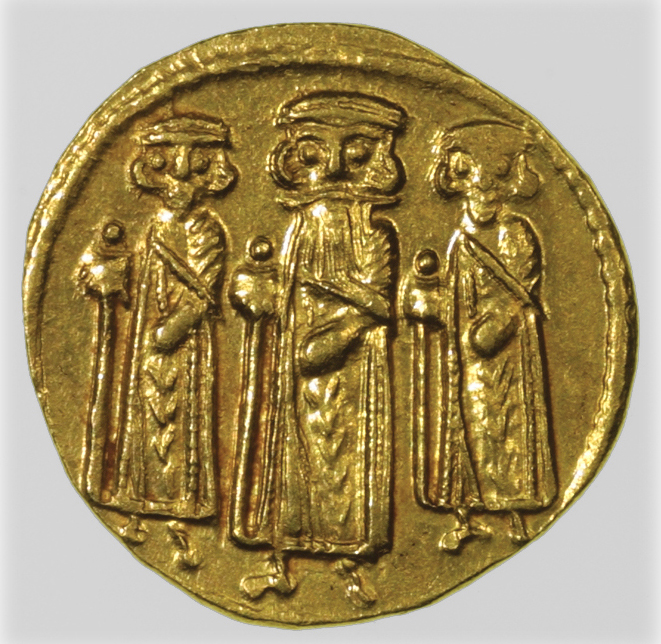
Location: mint: Darabjird
Dimensions: 4.04g; 31mm
Accession Number: AR 3
Other Notes:
Obverse: standard Arab‑Sasanian, with myawya amyr / y-wrysnykan (Mu‘awiyah amir al-mu’minin); margin: bism Allah, with triangle of dots to either side of bottom sun-moon symbol.
Reverse: has mint abbreviation DA downwards on right and date on left. No symbols in reverse margin, but a raised area above the sun-moon symbol at 3:00 suggests something was erased from the die.
Although 43 is plausible as a Hijri date for Mu‘awiya (r 41–60 AH/ 661–680 AD), it is the present consensus of specialists that this date was used for a period of some thirteen or fourteen years with various officials on the obverse, making the actual period of this issue impossible to define.
